Shoji White SW-7042 by Sherwin-Williams
Explore the color from undertones to the rooms it is best to be used in
Choosing paint colors for your home is a responsible task since you are going to live with those colors on your walls for quite a while. And since repainting your home interiors and surfaces (and especially repainting the exterior walls!) is quite a bothersome business, most homeowners prefer to figure out what paint color they need in advance.
It is much easier to find matching paint than messing around with endless cans of paint and brushes each time you don’t like your new wall tint.
This is why this article will be handy for those who think of using a paint color called Shoji White by Sherwin-Williams brand in their homes. We will tell you what kind of color it is, what its undertones are, and how this paint may react to light after you apply it to your walls.
Also, you are going to learn what rooms this color will look the best in, and what similar colors can be used.
Finally, we will tell you more about the paint colors that go well with Shoji White paint, as well as what color can be used for the trim along with it.
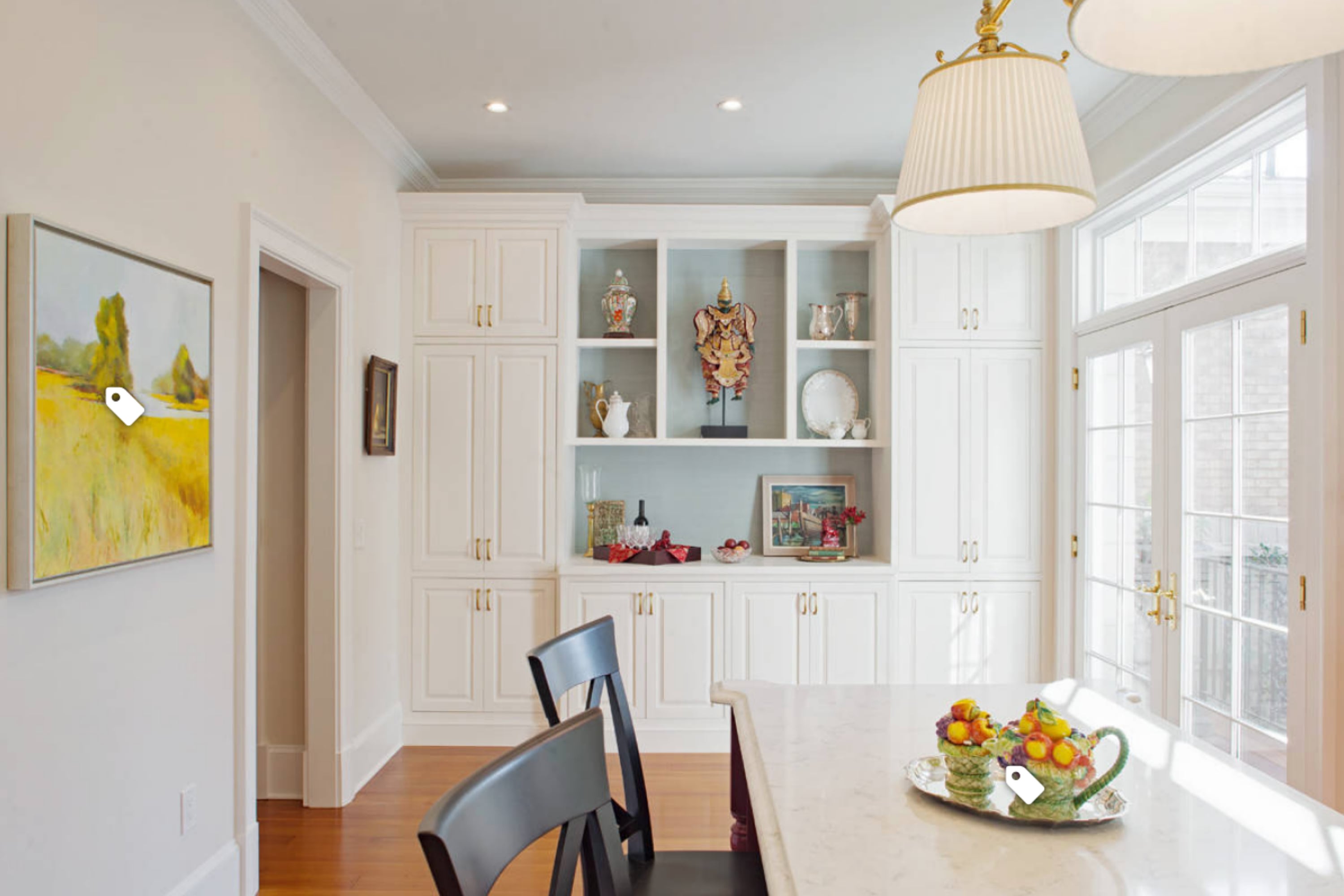
houzz via VistaCreate
What Kind Of Color Is Shoji White SW-7042?
Table of Contents
Shoji White paint color by Sherwin-Williams brand is quite a tricky color! See, even though its name contains the word “white”, Shoji White is a creamy and very pale shade of beige. As Encycolorpedia says, it can sometimes look close to white, that’s true, but you should keep in mind that it is never greige!
This is quite a soft and muted color, warm-toned and cozy, so if you are looking fo a bright white or a crisp white shade to have on your walls, this color is definitely not what you need!
But if you are looking for a very classical and pretty beige paint color that can sometimes look like whiye on your walls, Shoji White might be your best choice. It looks equally as lovely in a living room or dining room and works perfectly with most hardwood floors.
Also, Shoji White is pretty versatile in terms of use. You can apply it in many other rooms except for your living room, and it can be successfully combined and paired with many other colors and textures in your home.
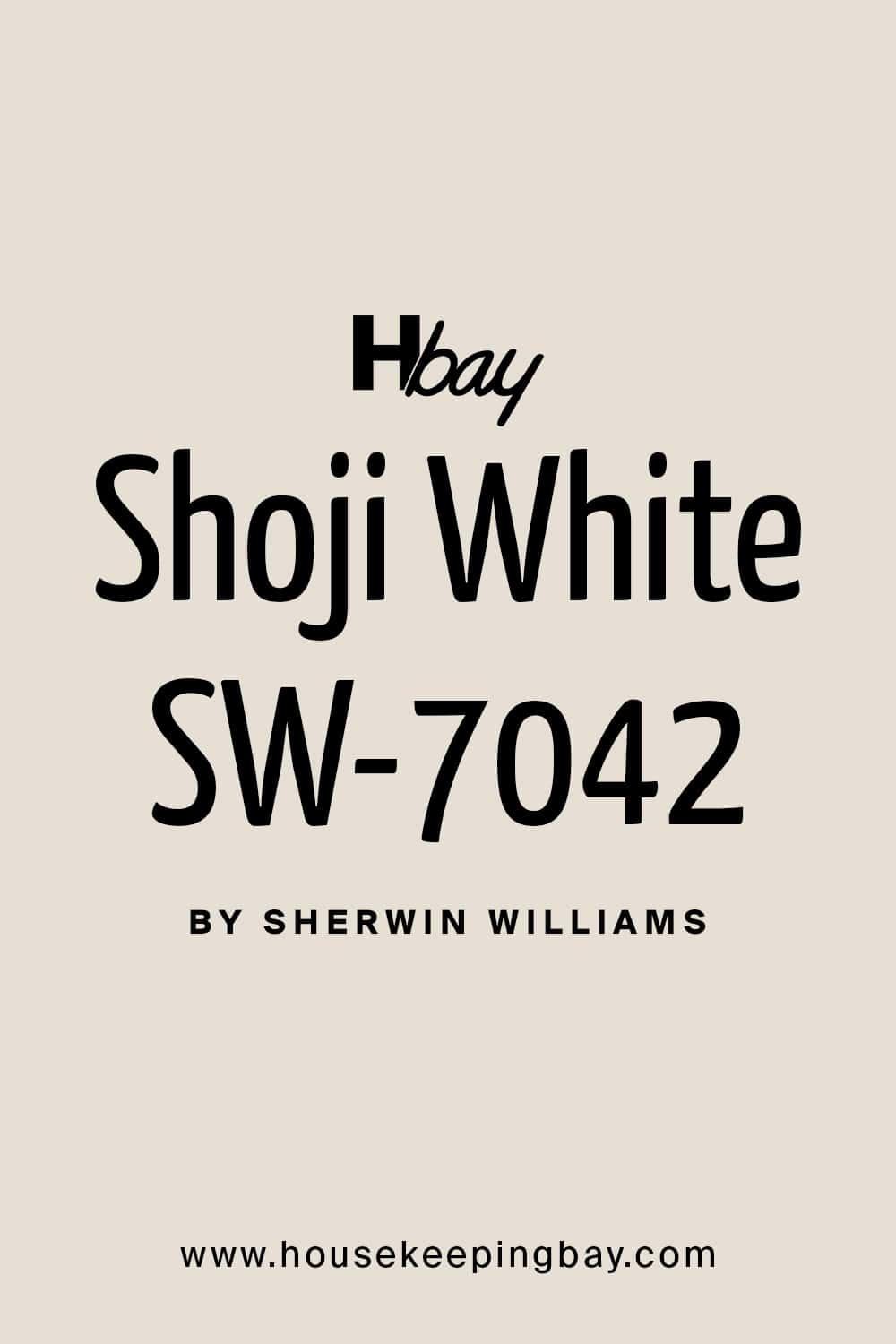
housekeepingbay.com
Shoji White Undertones
Undertones can make your paint color a bit tricky in terms of how it looks on the walls. This is why it is important to consider them before you decide to buy a can or two of certain paint color. In particular, this is an essential thing to do when you are dealing with such a complex and tricky color as Shoji White!
As for the Shoji White paint color by Sherwin-Williams, you need to know that this color is in the orange color family, so it has creamy beige undertones. However, some homeowners report it looking a little pinkish or peach, so you will definitely want to check how it will work and read all over your home, and in your particular type of lighting.
Also, you should keep in mind that Shoji White by Sherwin-Williams has no hint of a gray undertone in it! So don’t be tempted to consider this color greige. Additionally, on exterior walls, it never looks pink or even beige. It looks creamy white. Besides, this beige has a great feature: Shoji White almost never looks yellow, which makes it easier to use.
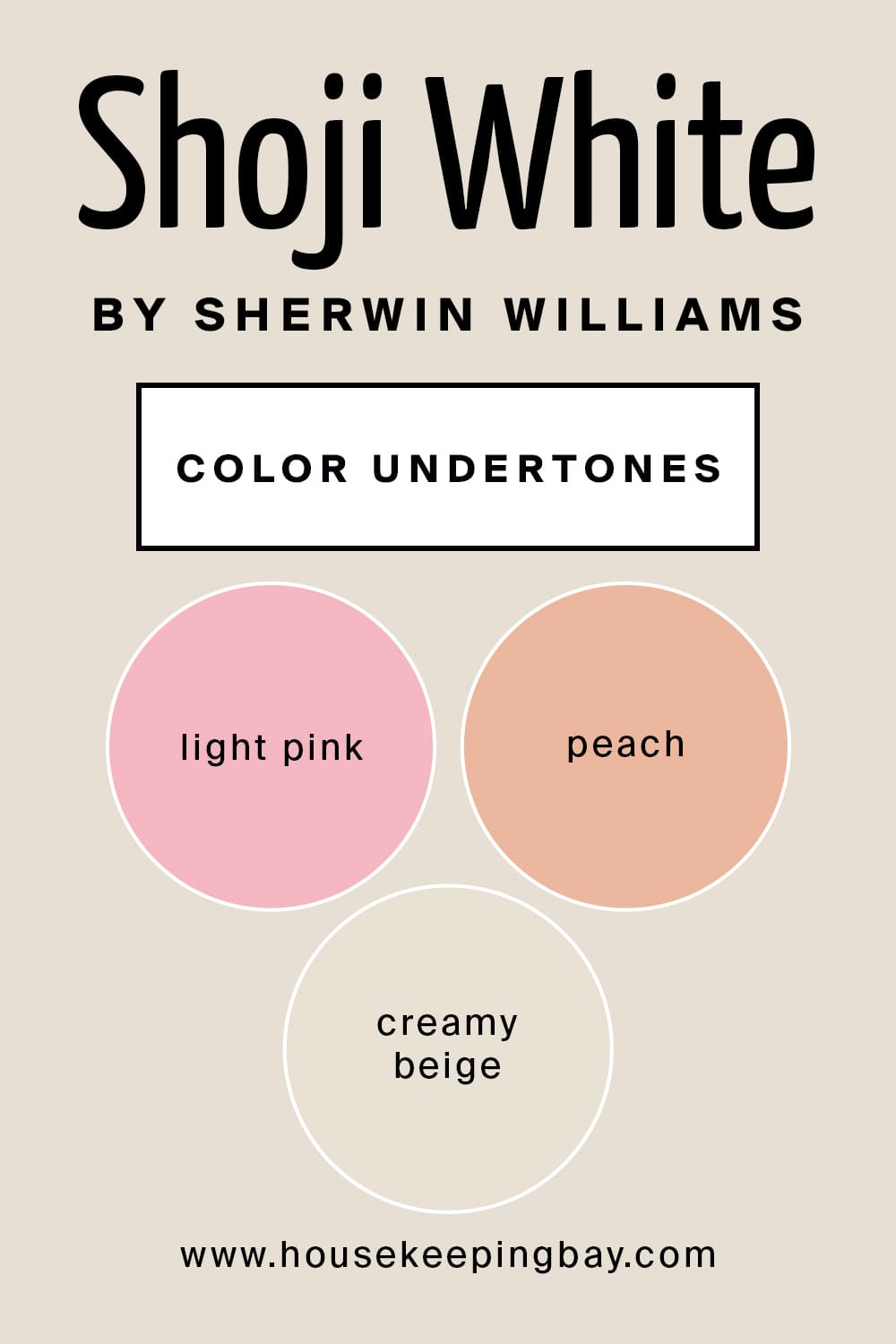
housekeepingbay.com
How Shoji White SW-7042 Color Reacts to Light?
Being aware of how certain paint colors might react to light can be very helpful. Like this, you can tell in advance how this or that color will show itself on your home walls. But to be able to do that, you need to know what LRV the paint color has.
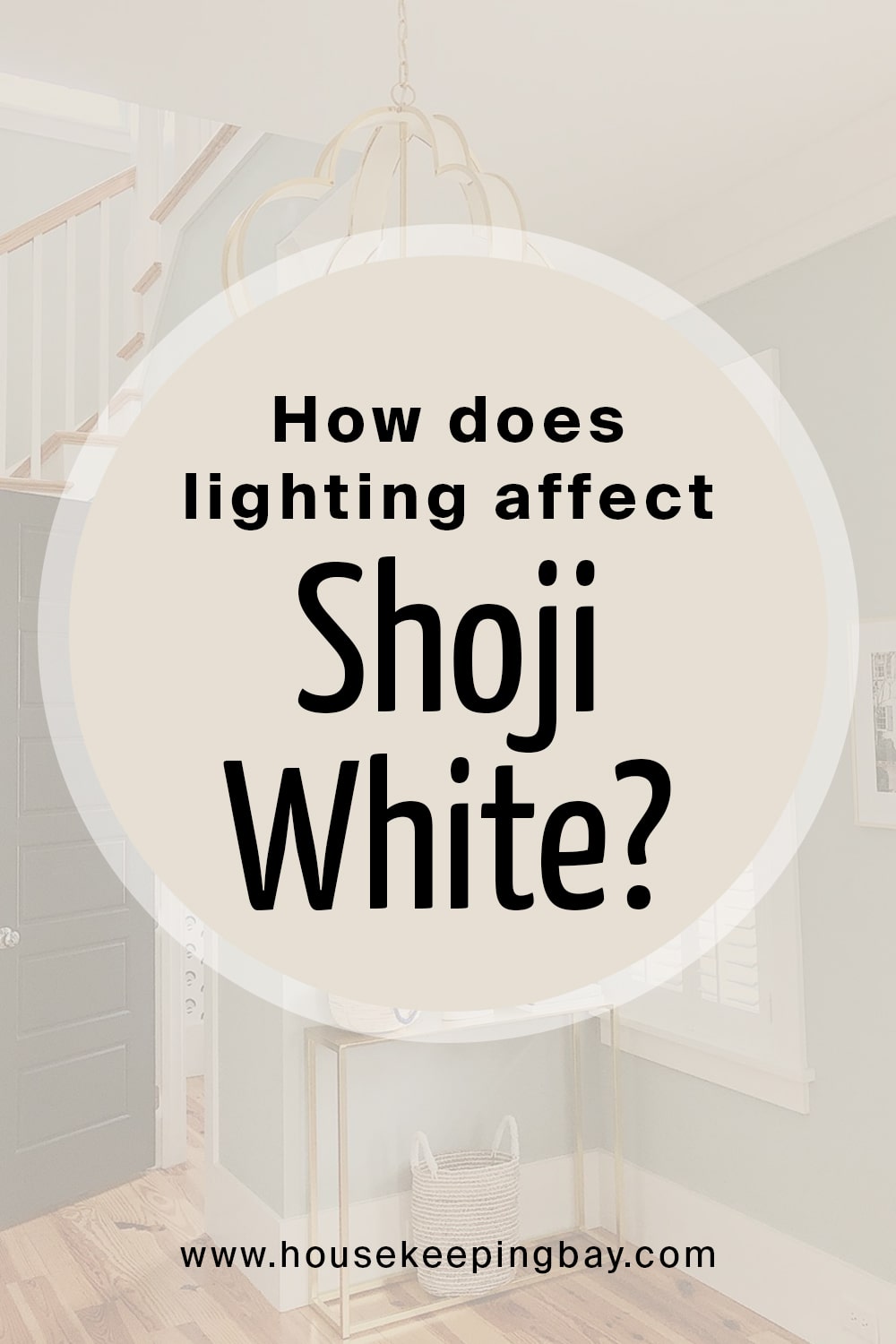
housekeepingbay.com
For those of you who don’t know what LRV is, here is a brief explanation. LRV is an abbreviation for Light Reflectance Value. It shows how much light paint color is able to reflect.
LRV runs on a scale from 0% – 100%, and 50% is a mid-value paint color. The higher the LRV, the more light a color reflects back into the room. On the LRV scale, zero means the darkest black, and 100 means pure white.
Shoji White color has an LRV of 74. What does this mean, exactly? Well, you need to know that true white colors usually have an LRV of about 84 or higher, and off-whites have an LRV below 84. With the LRV of 74, SW Shoji White is in the darker off-white area of the color scale, which makes it close to beige/tan.
Like this, now you have a bit better understanding of this white paint color by Sherwin-Williams brand. And to help you figure out what other colors it might look good with, we recommend you check out a section below where we will tell you about the paint colors that might go well with Shoji White paint color.
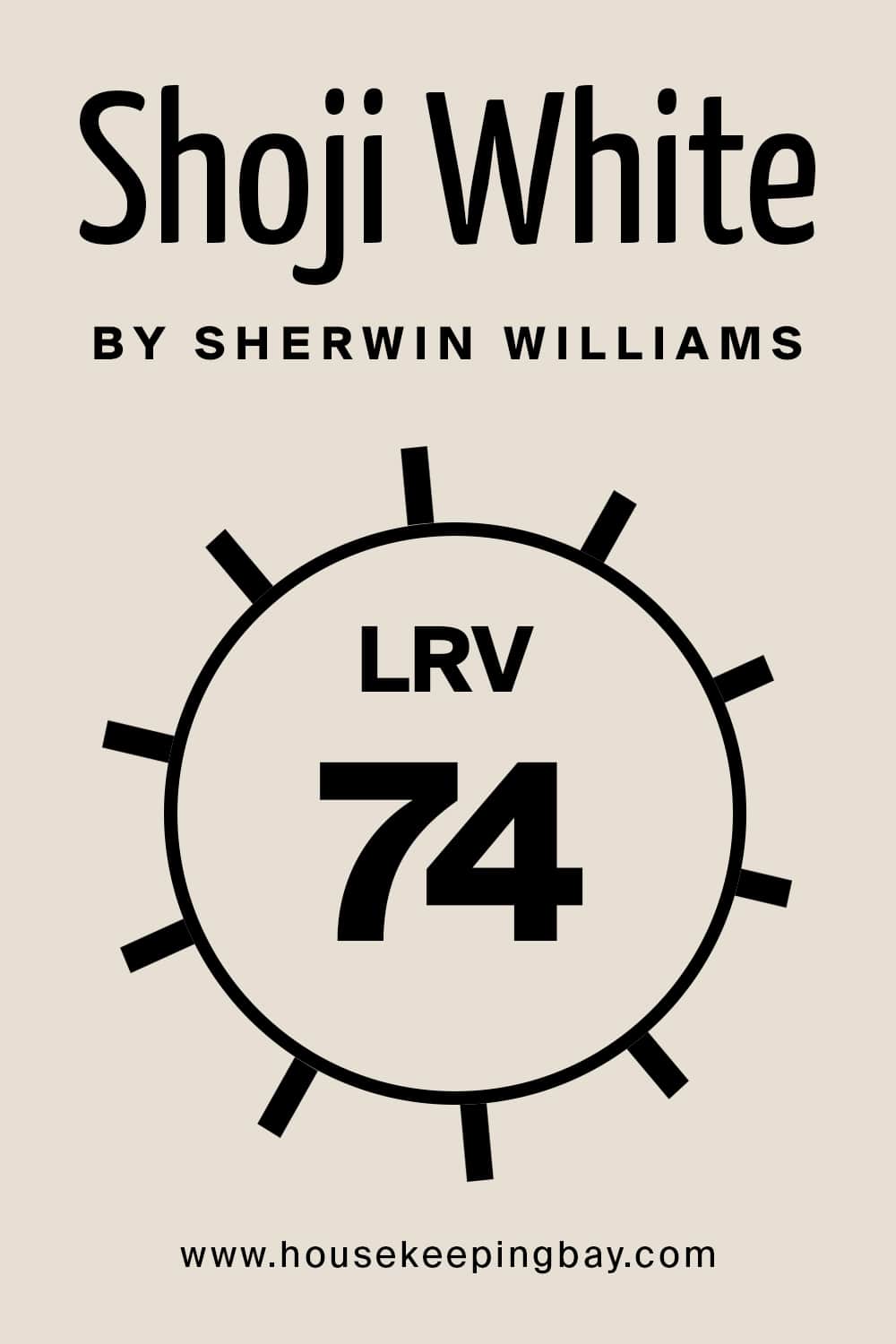
housekeepingbay.com
What is LRV? Read It Before You Choose Your Ideal Paint Color
Colors That Go With Shoji White Paint Color
Being a nice, warm-toned beige, Shoji White color looks well with most other colors. But if you don’t have enough experience in matching paint colors, you might find this task challenging. This is why we suggest you use the following paint colors that Shoji White goes well with should you need that:
- SW Sea Serpent
- SW Worldly Gray
- SW Haven
- SW Sea Salt
- SW Smoky Blue
- SW Stardew
- SW Poolhouse
- SW High Reflection White
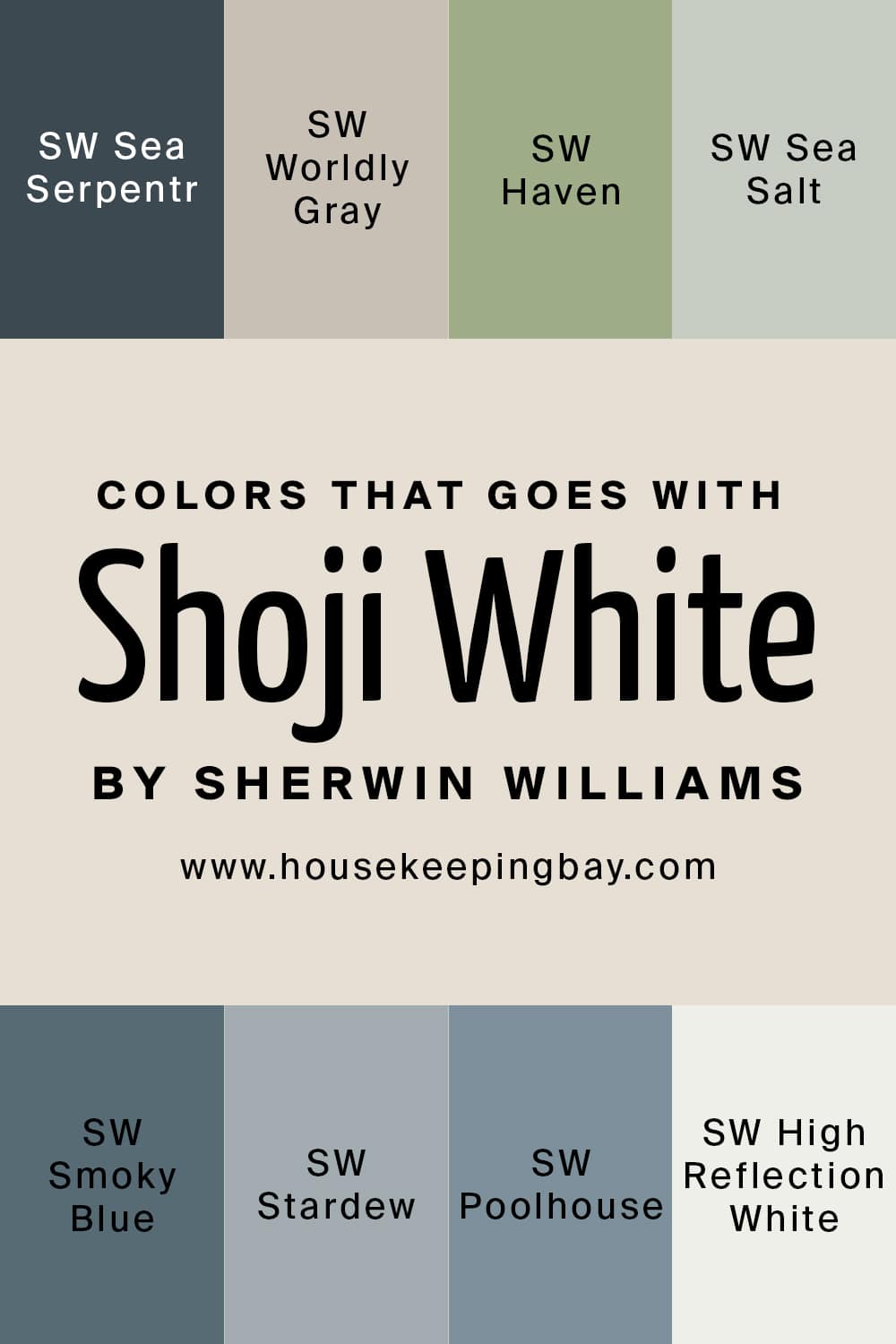
housekeepingbay.com
The Best Trim Colors For Shoji White Paint
Usually, white is an ideal and universal trim color no matter what paint you have on the walls. But still, choosing a trim color that will pair well with the existing color on the walls can often be complicated! With Shoji White, the best white paint for trim totally depends on your goal.
If you want this beige to look as white as possible, use it on everything, including the trim, ceilings, and doors. If you do want it to look white, choose a creamy white like Greek Villa or Alabaster. Snowbound could be a good option as well.
But if you want your trim and doors to pop, you should choose something like Sherwin-Williams High Reflective White, or Behr Ultra Pure White.
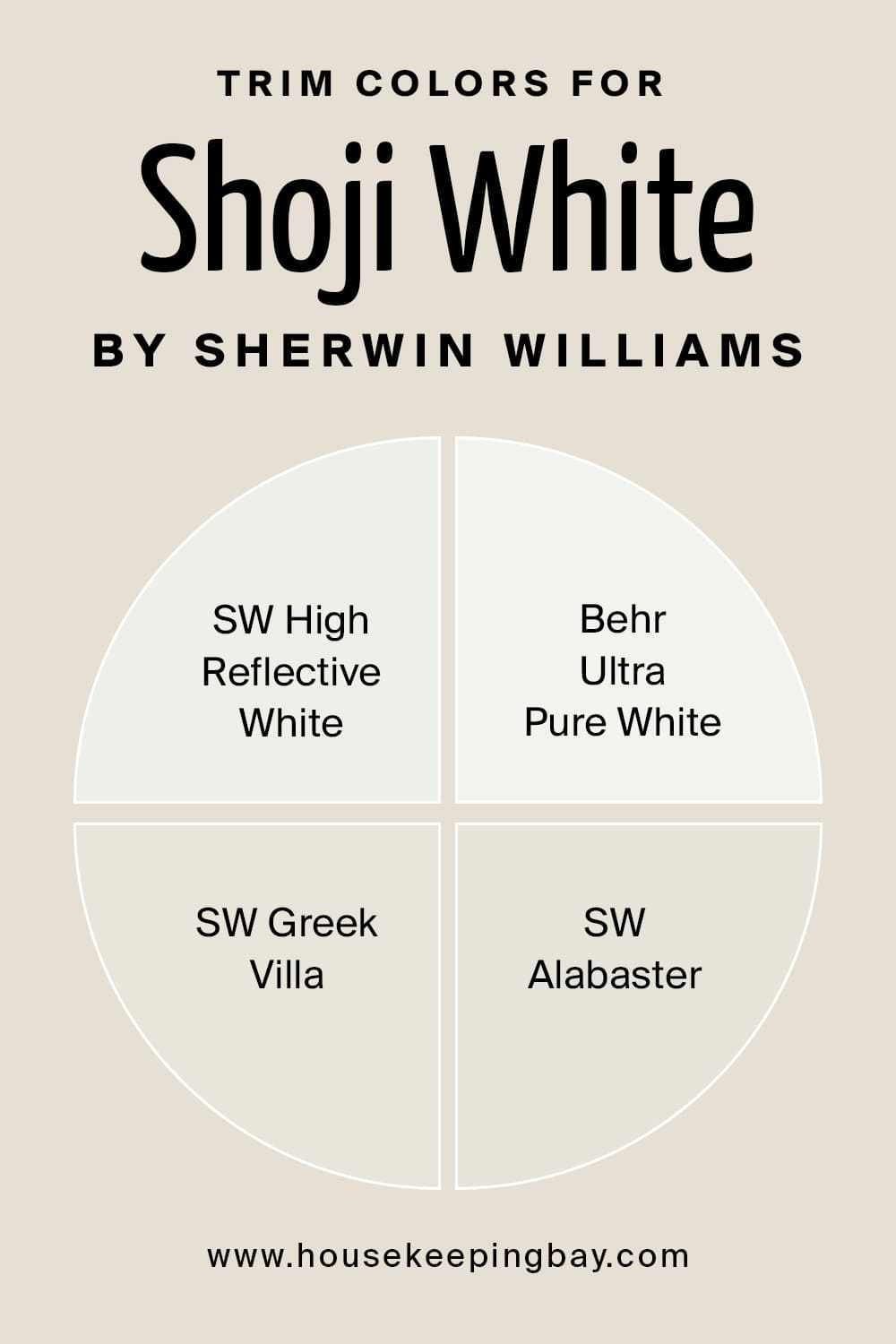
housekeepingbay.com
Best Complimentary Colors for Shoji White SW 7042
Shoji White SW 7042 by Sherwin Williams is a soft off-white with a warm undertone. It fits easily into neutral color schemes but also pairs well with richer and cooler tones. The shades below help build a palette that feels grounded and balanced.
Drift of Mist SW 9166 is a light gray with a hint of warmth, ideal for pairing walls and trim.
Dorian Gray SW 7017 brings a greige tone that adds a quiet, grounding element to the mix.
Alabaster SW 7008 offers a slightly warmer white, great for layering soft neutral tones.
Gauntlet Gray SW 7019 is a bold charcoal that works well in accents like doors or fixtures.
Blustery Sky SW 9140 adds a dusty blue note for a cool contrast that doesn’t feel harsh.
Icy SW 6534 is a pale, airy blue that brings a subtle and fresh shift in tone.
Possibly Pink SW 6308 is a soft blush that adds a gentle touch of warmth and charm.
Toasty SW 6095 offers a rich, medium brown tone that helps highlight Shoji White’s creamy warmth.
Where Shoji White Color Can Be Used?
SW Shoji White is rather versatile as we already told you. You can basically apply it in almost any room in your home. But still, we would recommend you check out the descriptions below in order to see how exactly this white can show itself in different spaces.
Shoji White in the Living Room
This beige will look stunning in a living room if the space is well lit and has plenty of daylight. But even in a smaller living room Shoji White will read and look wonderful! And since it is white (which means it is versatile), this color can be a great background for any interior design and decor.

housekeepingbay.com
Shoji White in the Bedroom
If you are looking for a paint color to have a cozy and airy yet not too cool vibe in your bedroom, try painting its walls with Shoji White. This color soft and warm-toned will make the room look more spacious and at the same time airy and bright. And since this white is warm-toned, you will not feel the “coldness” that cool-toned colors give.
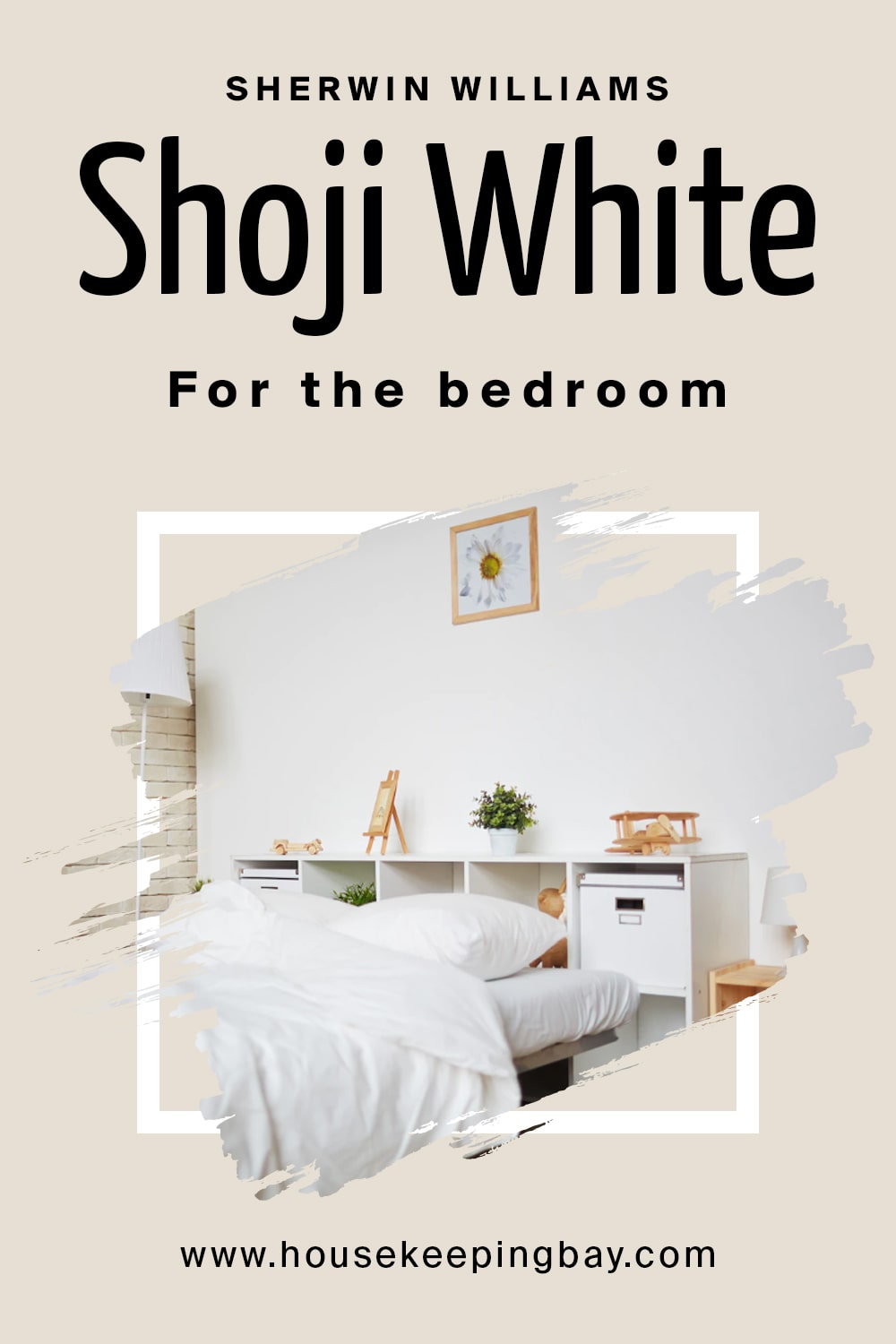
housekeepingbay.com
Shoji White in the Kitchen
Even for the kitchen, this paint color is a good choice. It pairs well with brass or gold hardware, metal elements, as well as wooden furniture. Since it is rather versatile, Shoji White will create a harmonious combo with contrasting colors, such as black.
Besides, it looks really nice with wooden furniture and other objects made of this material. So don’t hesitate if you feel like experimenting!
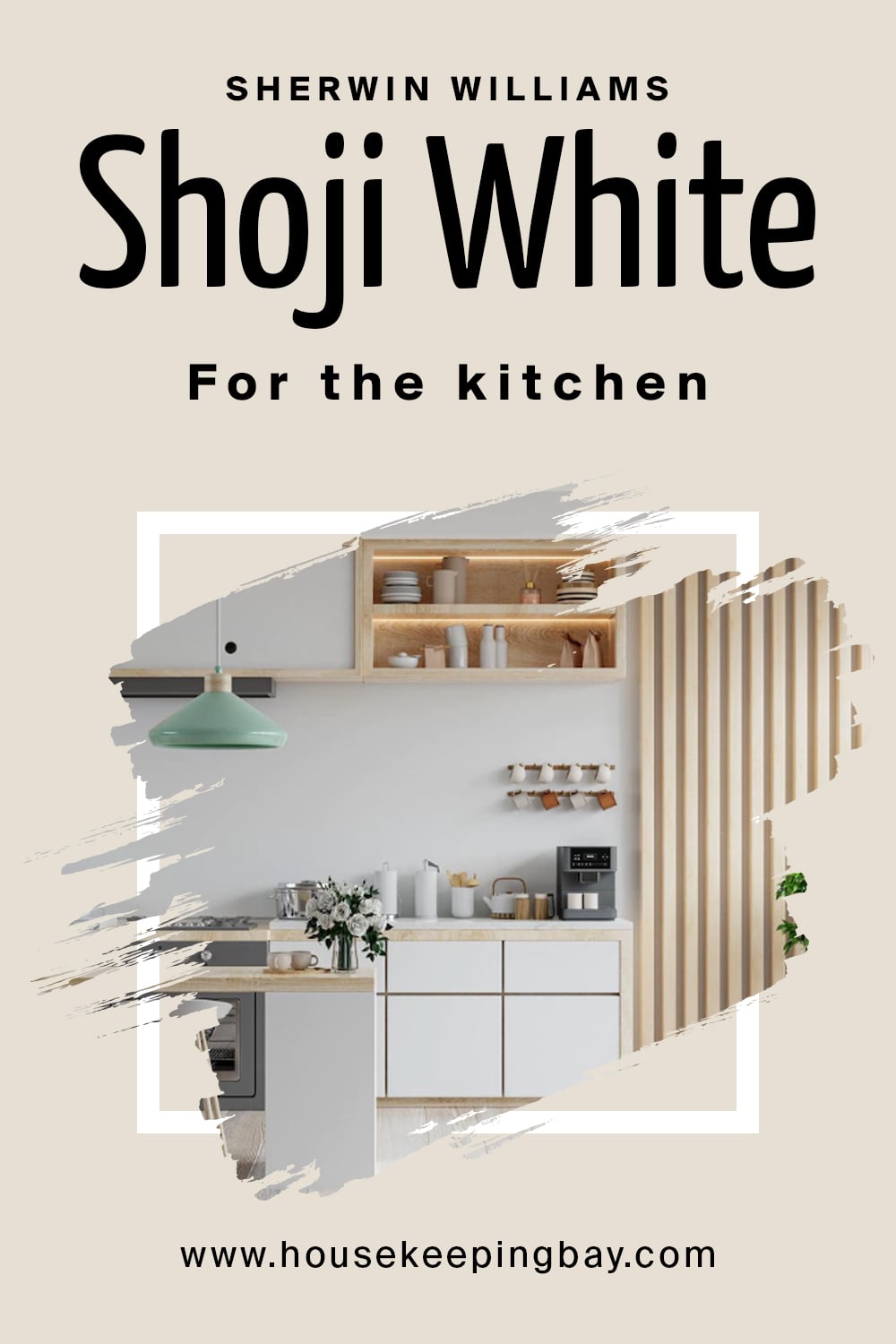
housekeepingbay.com
Shoji White in the Bathroom
For your bathroom, Shoji White is one of the most optimal color solutions. The color is bright and clear enough, but at the same time, it does not create a feeling of coolness due to its warm tones. Besides, this shade of beige can be combined well with different bathroom decor and stuff like handlers, holders, etc.
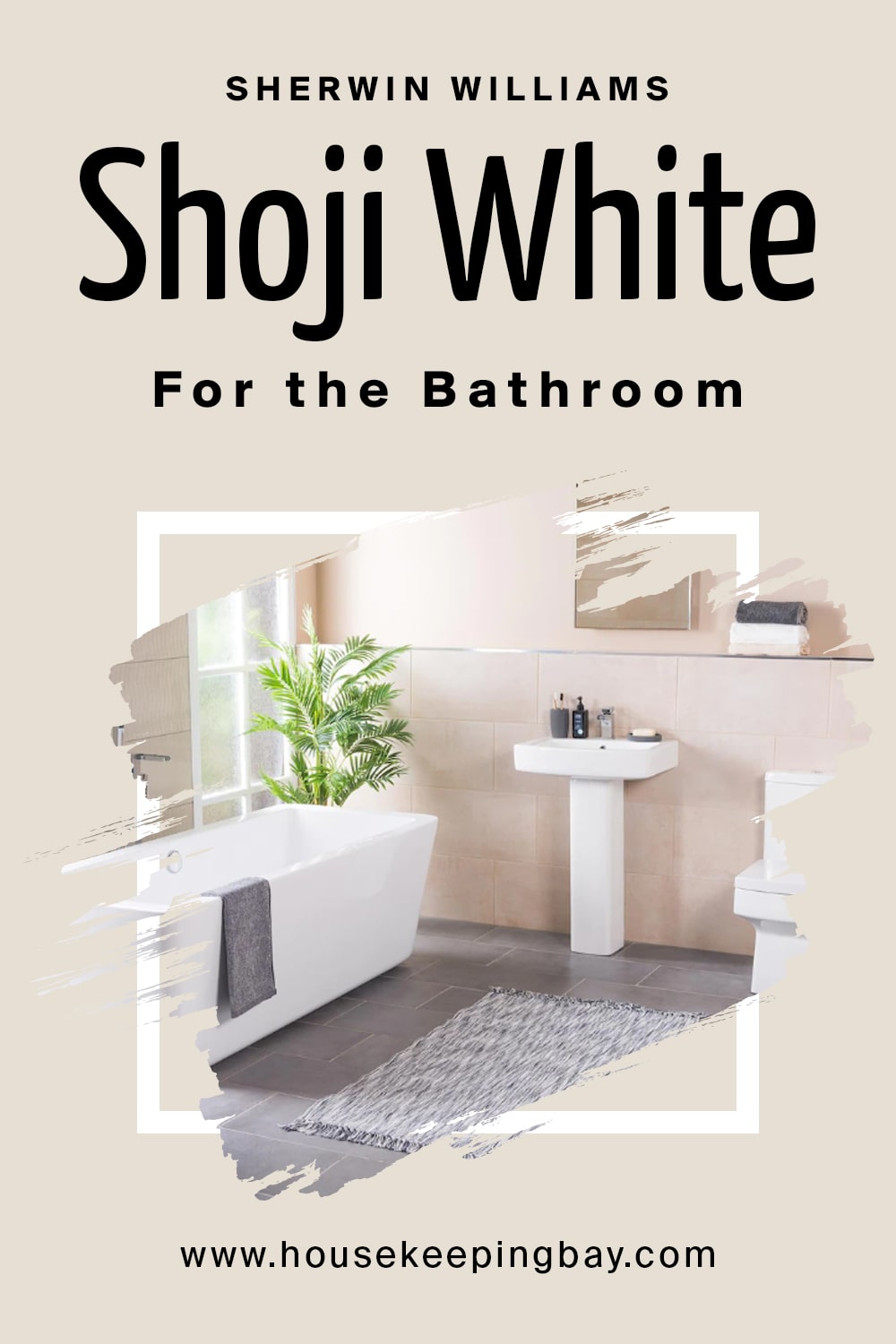
housekeepingbay.com
Shoji White for the Exterior
While some whites don’t work well when applied outdoors, Shoji White is an exception. It works surprisingly well on exterior walls! It reads nice and clean white that looks great on your home’s exterior siding or as an exterior trim color!
So, as you can see now, the Shoji White paint color by Sherwin-Williams is quite a versatile color even though it is white. So if you decide to refresh your home interior next time, don’t skip this color as one of the options!
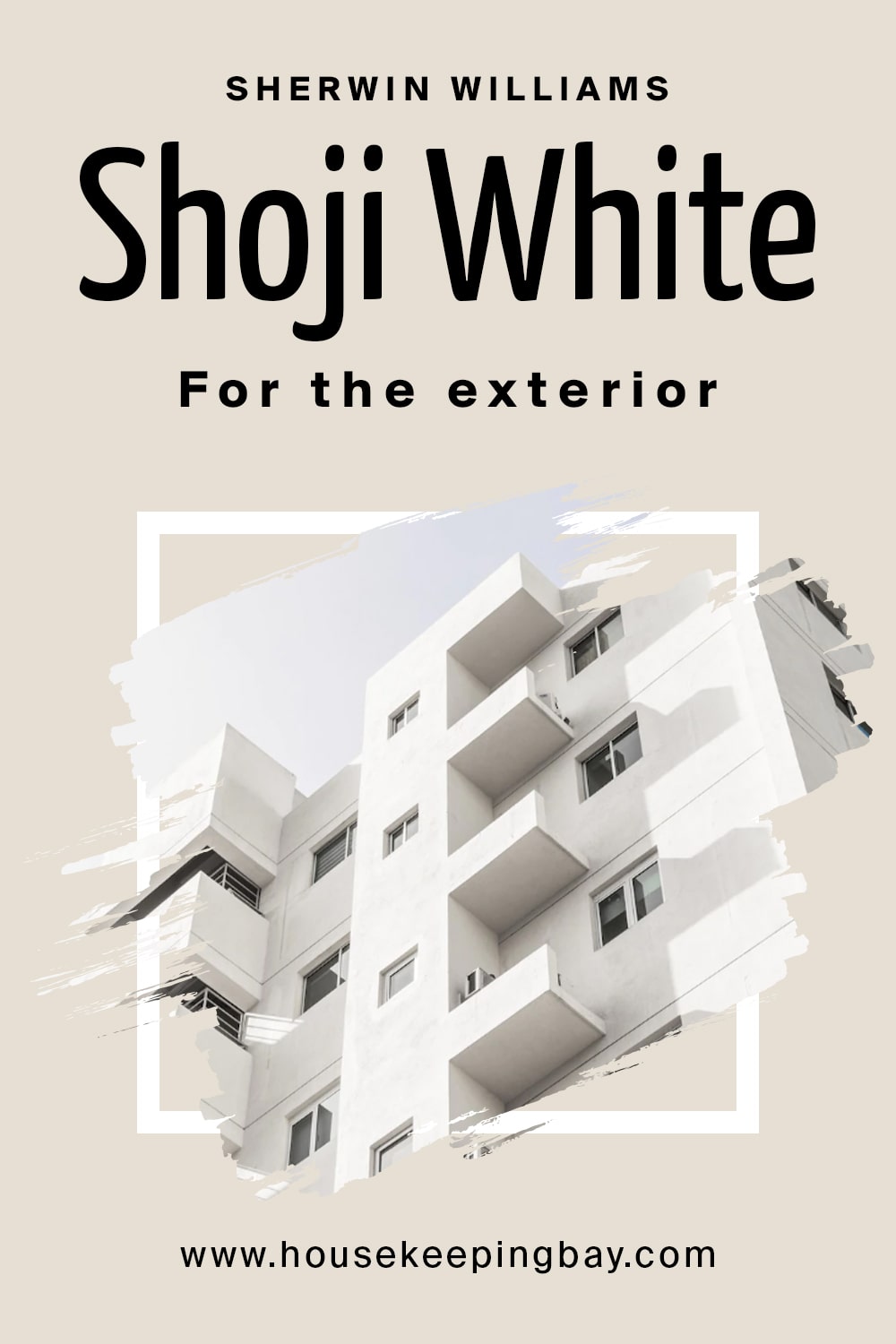
housekeepingbay.com
Paint Colors Similar to Shoji White
If you happen to change your mind and decide that you need a slightly different shade of paint color than Shoji White, you will want to know what other similar hues can be used as alternatives and substituting colors.
Below, you can check a few such colors. Some of them a lighter than Shoji White whilst others are more or less darker. Some are warmer whilst others are cooler. It will allow you to pick the optimal color for your home, design, and color scheme of the space.
- Worldly Gray
- Amazing Gray
- Aesthetic White
- Accessible Beige
- White Flour
- Taupe of the Morning
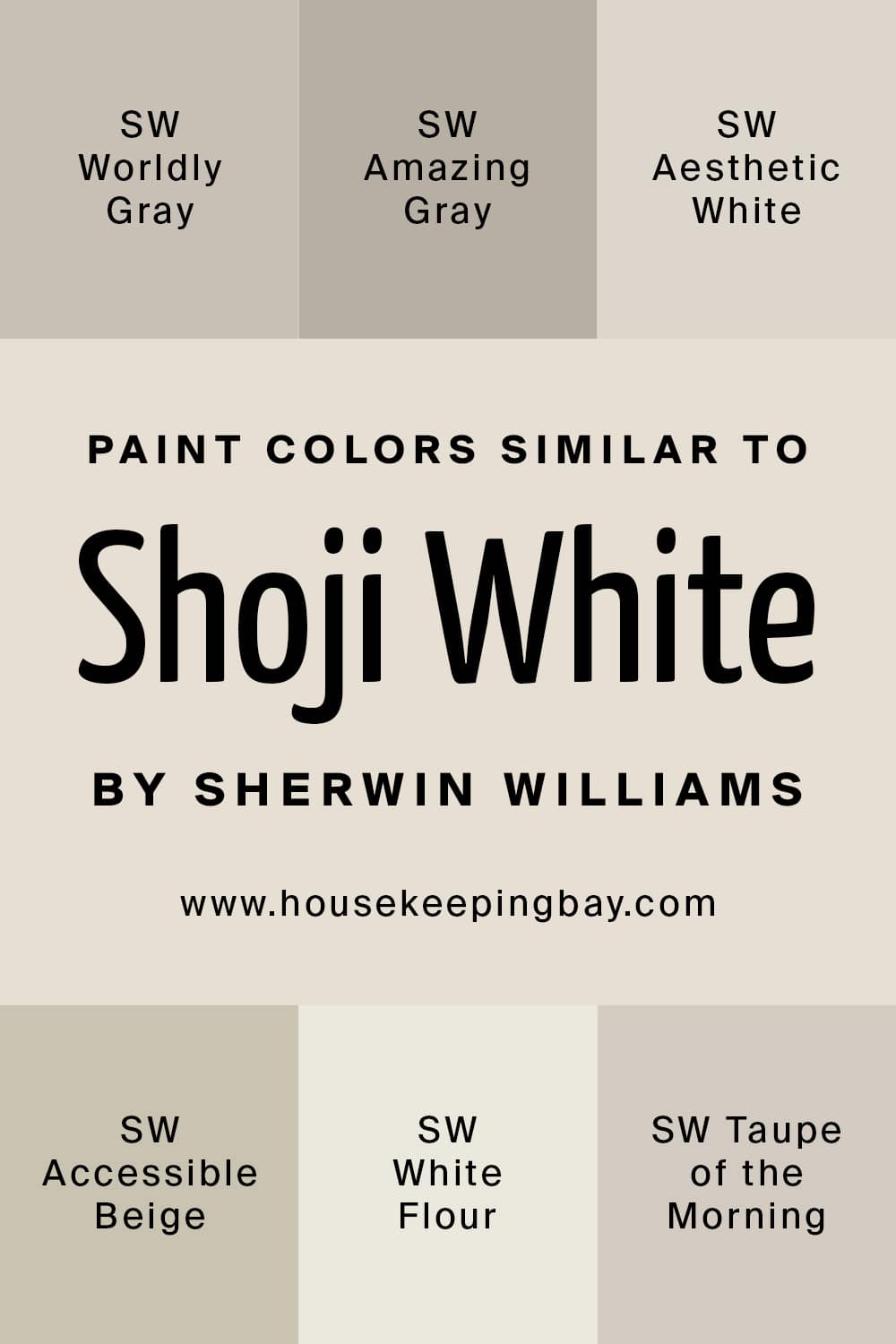
housekeepingbay.com
Shoji White Coordinating Colors
SW Shoji White looks really great with Tricorn Black if you are going for a modern farmhouse color scheme. Another paint color to coordinate with Shoji White is Sherwin Williams Clary Sage which is a nice complement to any creamy white. Also, Accessible Beige will be a nice choice for a monochromatic palette.

housekeepingbay.com
Color Pairings with Shoji White
Shoji White by Sherwin Williams is a warm, adaptable neutral that complements a variety of colors beautifully. Whether you’re aiming for a subtle, cohesive look or a striking contrast, these color pairings with Shoji White can enhance any space in your home.
Here’s how Shoji White pairs with some popular shades to create inviting and balanced designs:
Shoji White (SW 7042) and Urbane Bronze (SW 7048) Exterior
Shoji White and Urbane Bronze create a warm, sophisticated contrast for exterior walls. Shoji White offers a soft, neutral warmth with just a hint of beige, making it an excellent choice for larger surface areas. Urbane Bronze adds a deep, earthy accent, perfect for shutters, doors, or architectural details.
Together, these colors bring a timeless yet modern look to any exterior. Shoji White keeps the palette light and approachable, while Urbane Bronze introduces a touch of boldness, giving homes a classic but updated appeal that stands out.
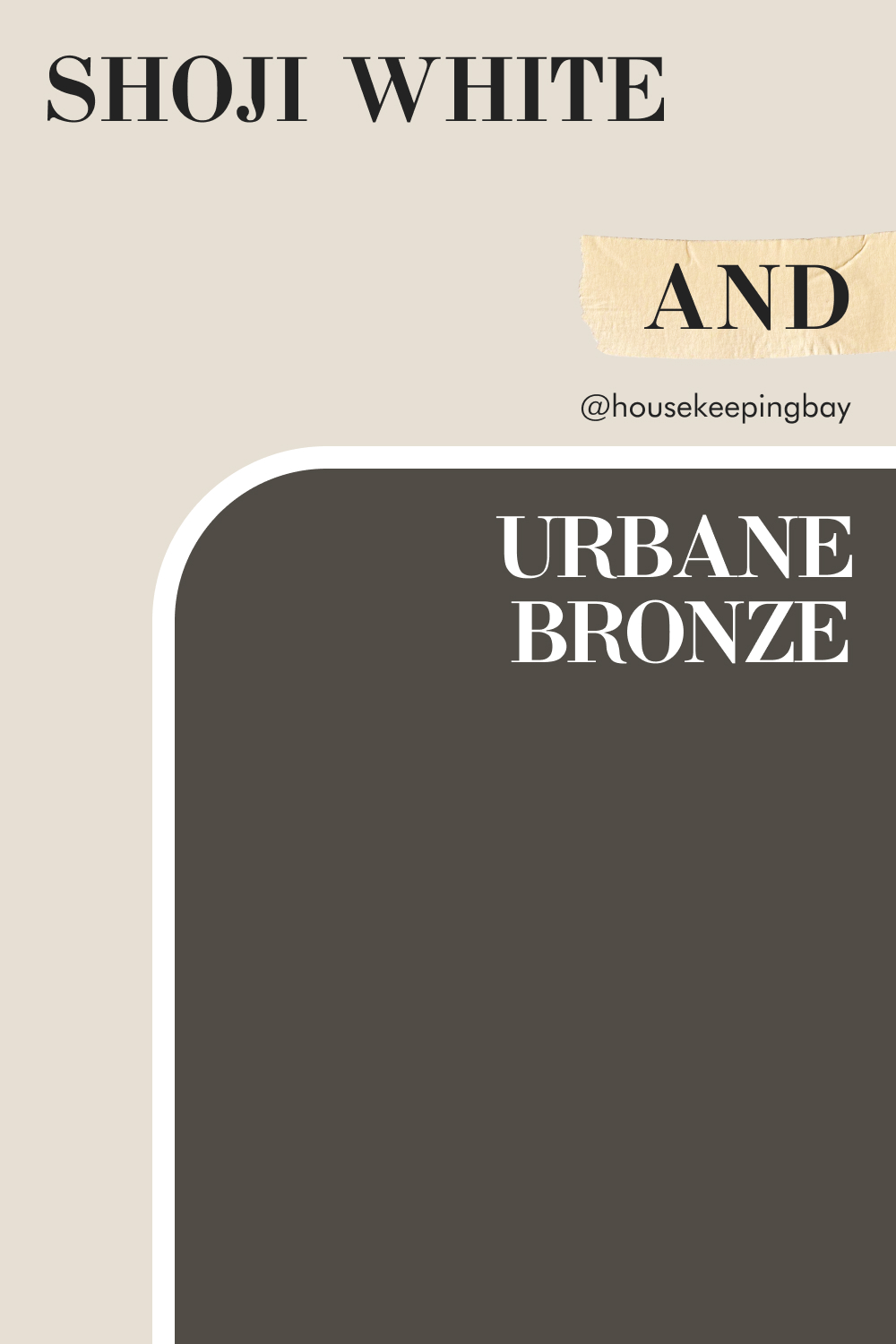
housekeepingbay.com
Shoji White (SW 7042) and Clary Sage (SW 6178)
Shoji White and Clary Sage make for a calming, nature-inspired pairing that’s perfect for any room. Shoji White’s soft, warm neutral undertone pairs beautifully with Clary Sage’s gentle green, creating a relaxing environment that’s easy to enjoy every day.
This combination offers a balanced look, where Shoji White keeps spaces light and airy, and Clary Sage introduces a touch of nature indoors. Together, they create a harmonious palette that feels fresh and comfortable, suitable for living rooms, kitchens, or bedrooms.

housekeepingbay.com
Shoji White (SW 7042) and Dried Thyme (SW 6186)
Shoji White and Dried Thyme offer a sophisticated and earthy color combination. Shoji White’s creamy undertones keep a room feeling spacious, while Dried Thyme brings a grounded, muted green that adds depth to any space.
This palette is versatile, working well in any area of the home. Shoji White keeps the look light, while Dried Thyme adds a soft, natural touch, making it a perfect choice for spaces like bedrooms or entryways for a welcoming atmosphere.
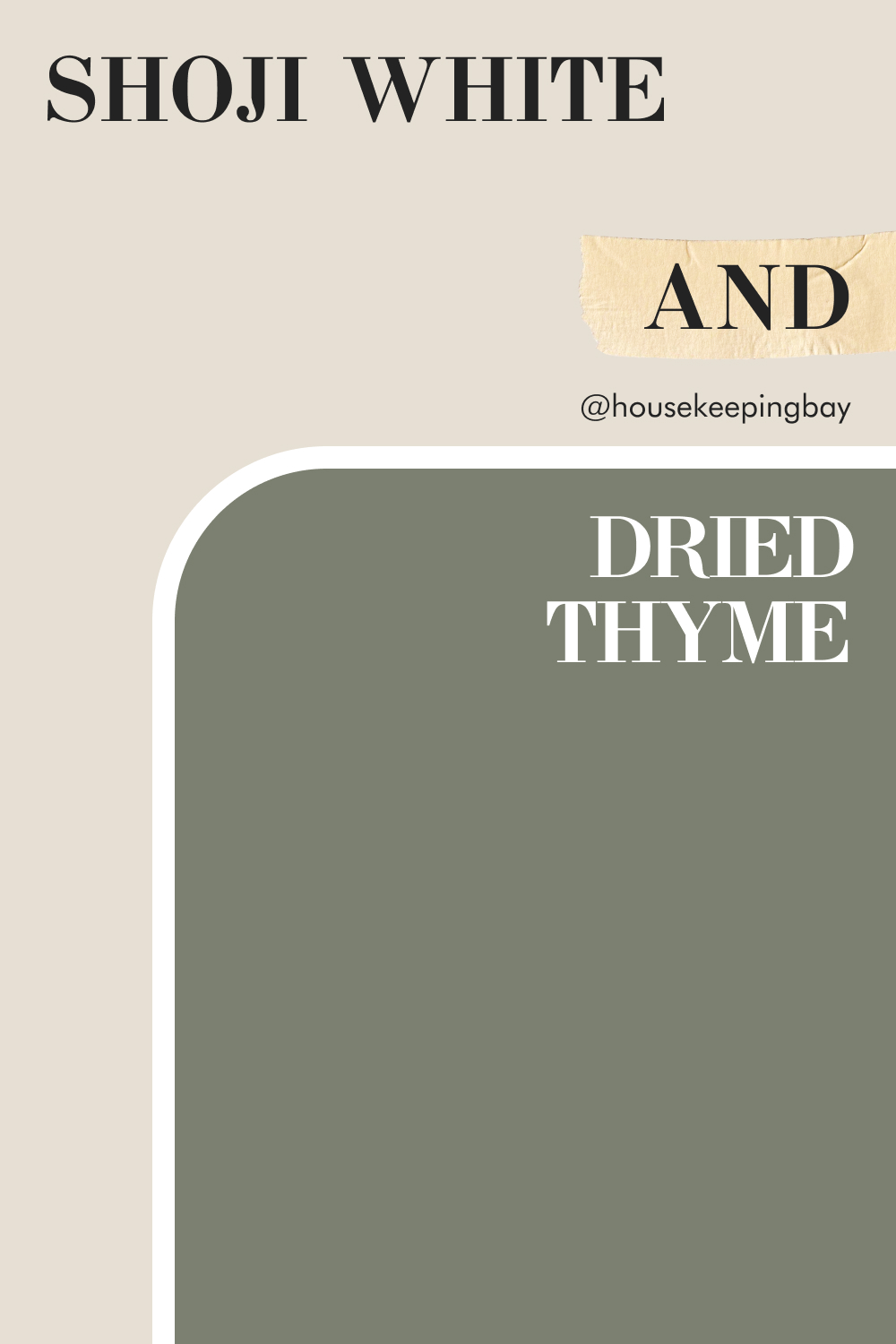
housekeepingbay.com
Shoji White (SW 7042) and Hale Navy (HC-154)
Shoji White and Hale Navy are a classic color combination with timeless appeal. Shoji White’s soft warmth balances out the deep, rich tone of Hale Navy, creating a bold yet inviting look perfect for living rooms, kitchens, or exteriors.
This pairing brings a sense of calm with a hint of drama. Shoji White keeps the space bright and airy, while Hale Navy adds sophistication, making it an ideal choice for both modern and traditional designs.

housekeepingbay.com
Shoji White (SW 7042) and Jogging Path (SW 7638)
Shoji White and Jogging Path create a beautifully layered, soft-toned palette. Shoji White’s warmth complements the subtle, earthy gray of Jogging Path, offering a grounded yet airy look that’s perfect for any room.
Together, these colors create a peaceful environment, where Shoji White brightens up the space while Jogging Path adds depth. This combination is ideal for a cohesive, elegant feel in spaces like living rooms, bedrooms, or hallways.
Shoji White (SW 7042) and Kendall Charcoal (HC-166)
Shoji White and Kendall Charcoal create a modern, balanced contrast. Shoji White’s soft warmth is an excellent backdrop, while Kendall Charcoal brings a bold, grounded touch with its deep gray hue, adding sophistication to any room or exterior.
This pairing works beautifully for spaces needing a hint of contrast without overwhelming. Shoji White keeps the look light, and Kendall Charcoal offers depth, making it an ideal choice for accent walls, kitchens, or exteriors.
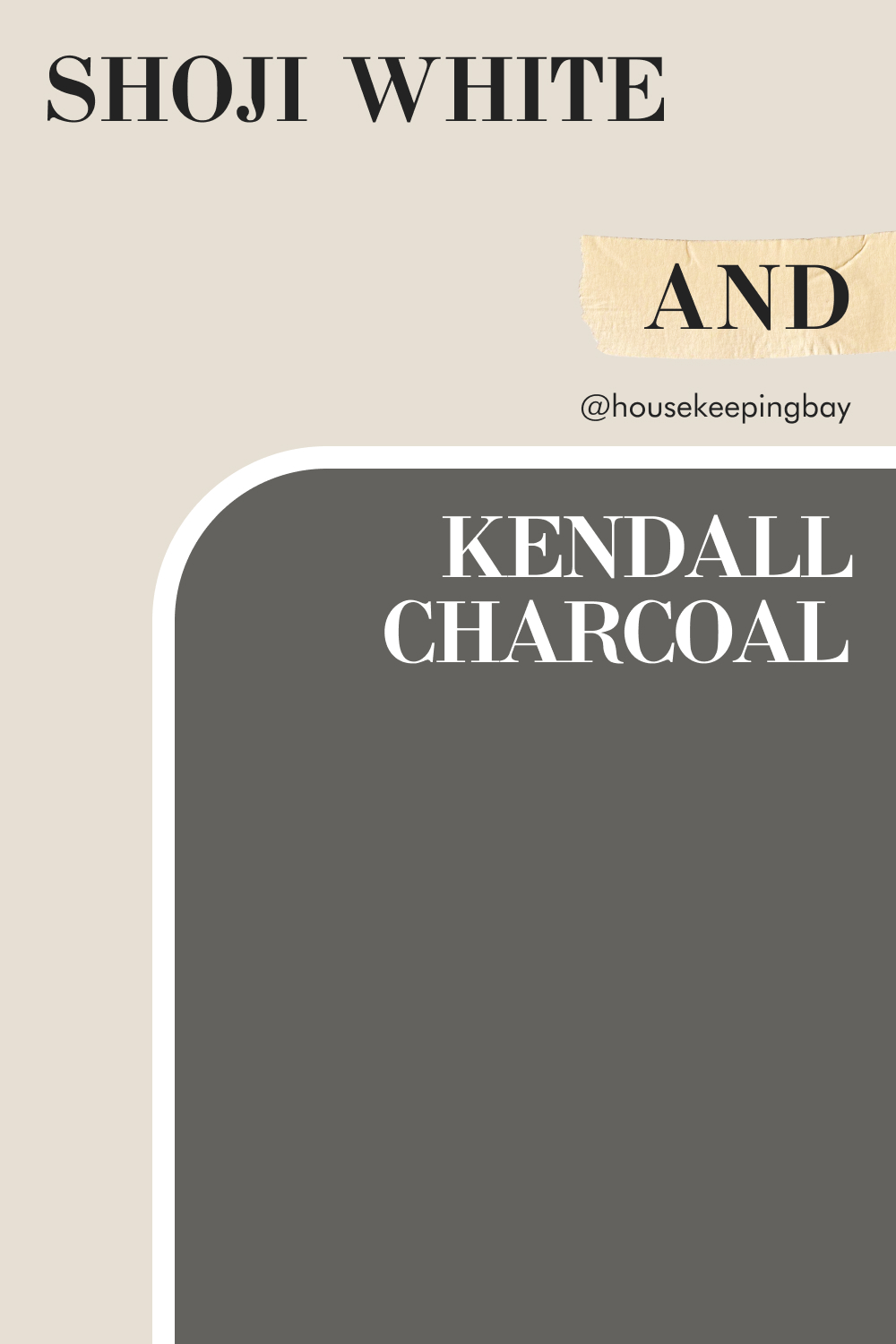
housekeepingbay.com
Shoji White (SW 7042) and Loggia (SW 7506)
Shoji White and Loggia combine soft warmth with an earthy, grounded tone. Shoji White provides a light and welcoming base, while Loggia adds subtle depth with its warm beige-gray hue, making it suitable for rooms needing a comfortable, balanced look.
This pairing is perfect for spaces that feel both inviting and sophisticated. Shoji White keeps things bright and airy, while Loggia adds a sense of calm, ideal for living rooms, dining rooms, or entryways.
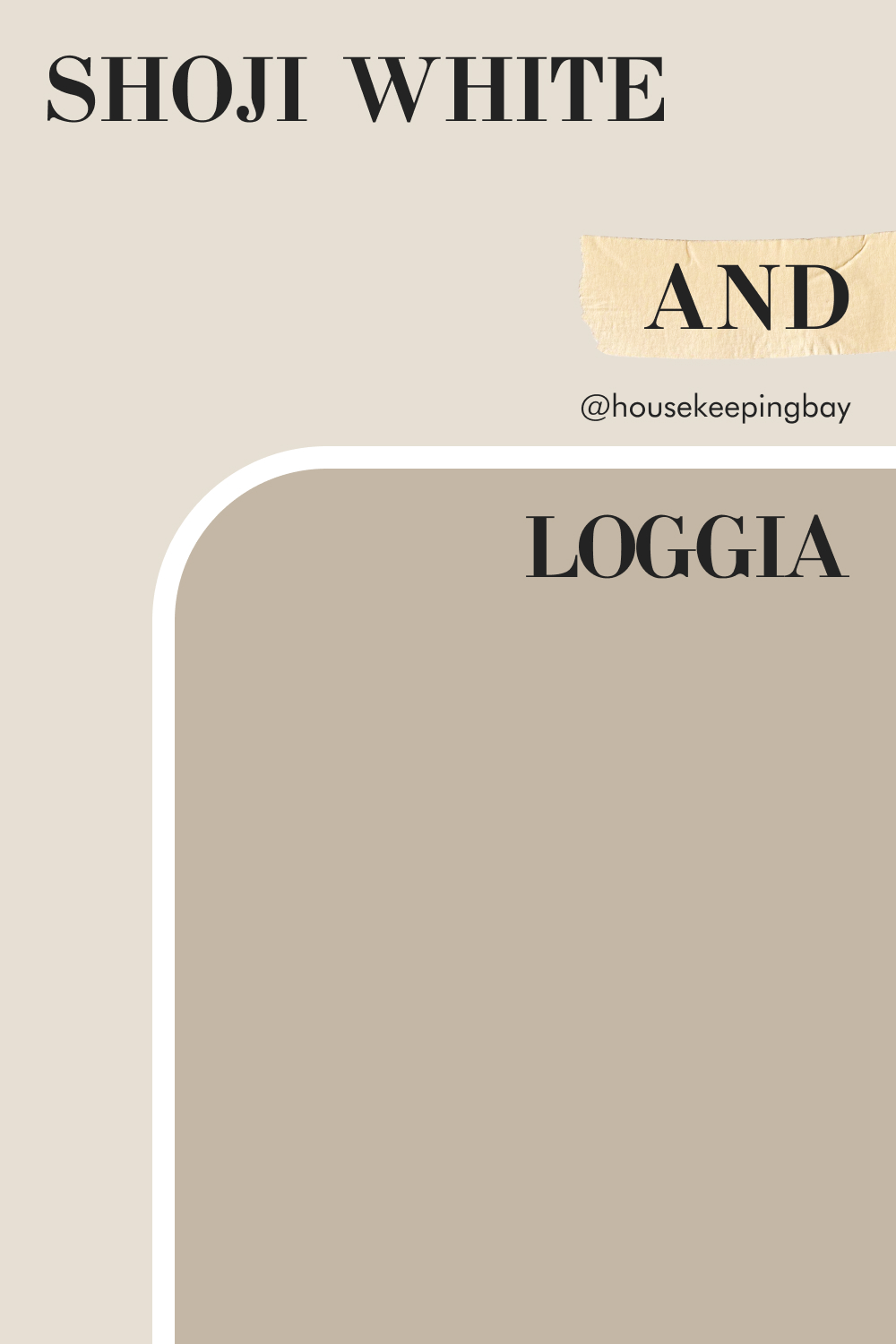
housekeepingbay.com
Shoji White (SW 7042) and Mindful Gray (SW 7016)
Shoji White and Mindful Gray offer a soft, versatile palette. Shoji White’s warm undertone adds brightness, while Mindful Gray’s balanced gray brings a calming effect, making this pairing perfect for a tranquil atmosphere.
Ideal for living rooms, bedrooms, or kitchens, this combination creates a fresh, understated look. Shoji White keeps spaces light, and Mindful Gray introduces a grounding note, offering a modern feel that’s easy to style around.
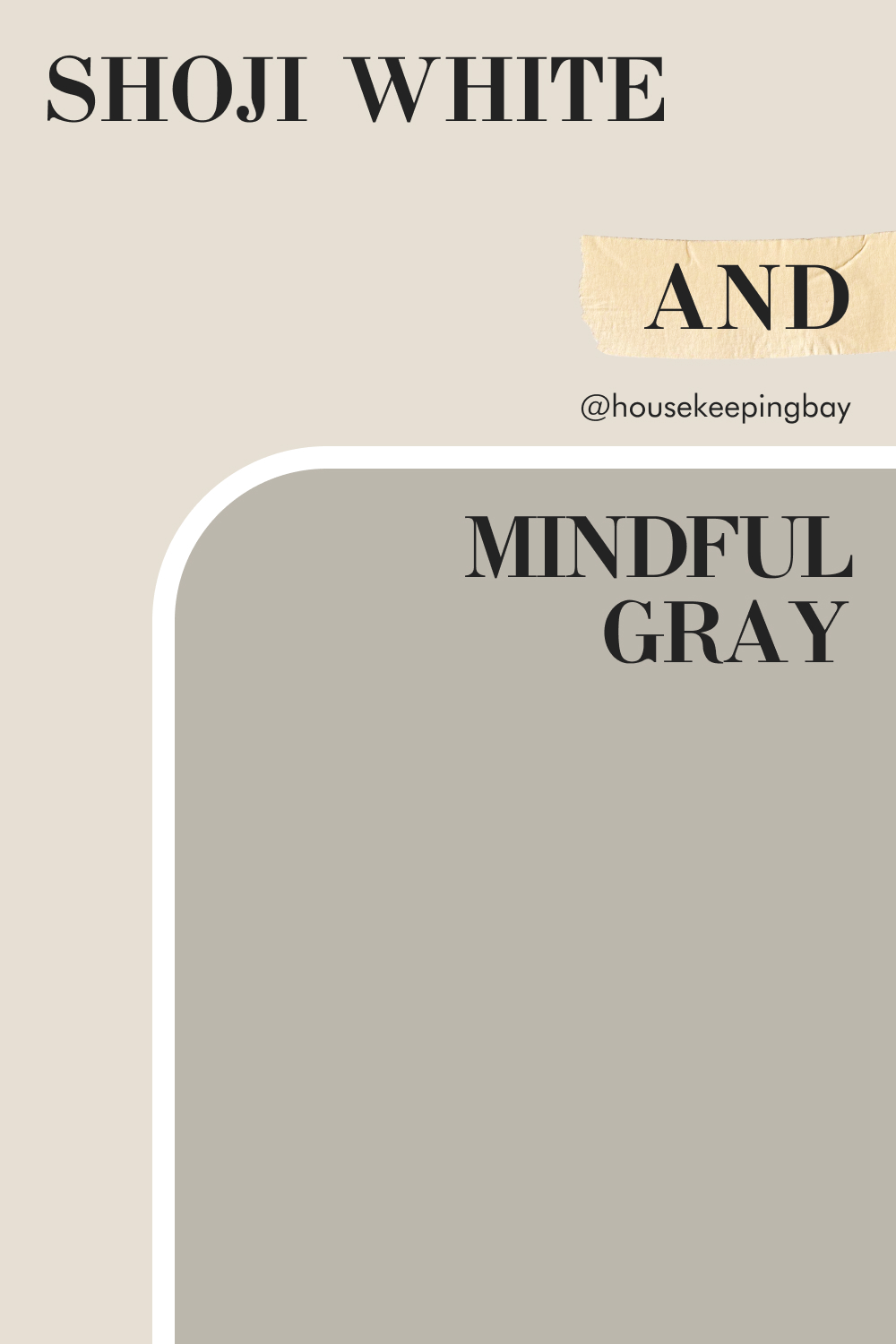
housekeepingbay.com
Shoji White (SW 7042) and Natural Linen (SW 9109)
Shoji White and Natural Linen form a warm, harmonious palette with subtle contrast. Shoji White offers a light, neutral base, while Natural Linen brings in a soft beige that feels cozy and inviting.
Perfect for living spaces or bedrooms, this color combination creates a comforting and elegant atmosphere. Shoji White keeps things airy, while Natural Linen adds a touch of warmth, ideal for cozy interiors with a sophisticated edge.
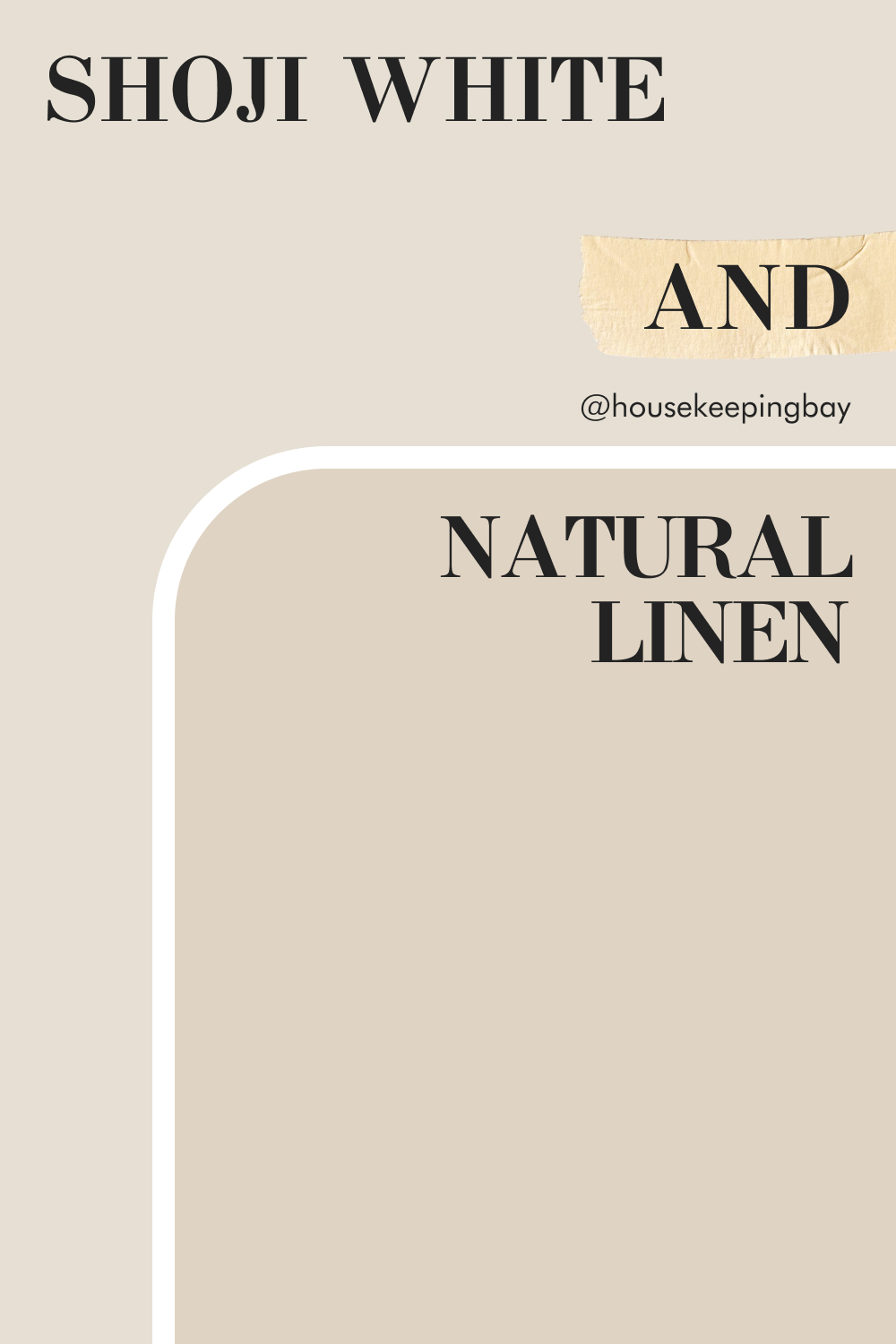
housekeepingbay.com
Shoji White (SW 7042) and Oyster Bay (SW 6206)
Shoji White and Oyster Bay provide a beautiful, balanced color duo. Shoji White’s soft warmth complements Oyster Bay’s muted, coastal green, creating a soothing environment that’s perfect for a fresh look.
This combination adds character without overwhelming. Shoji White brightens up the room, while Oyster Bay introduces a relaxed, natural feel, making it a great choice for bathrooms, kitchens, or living rooms.
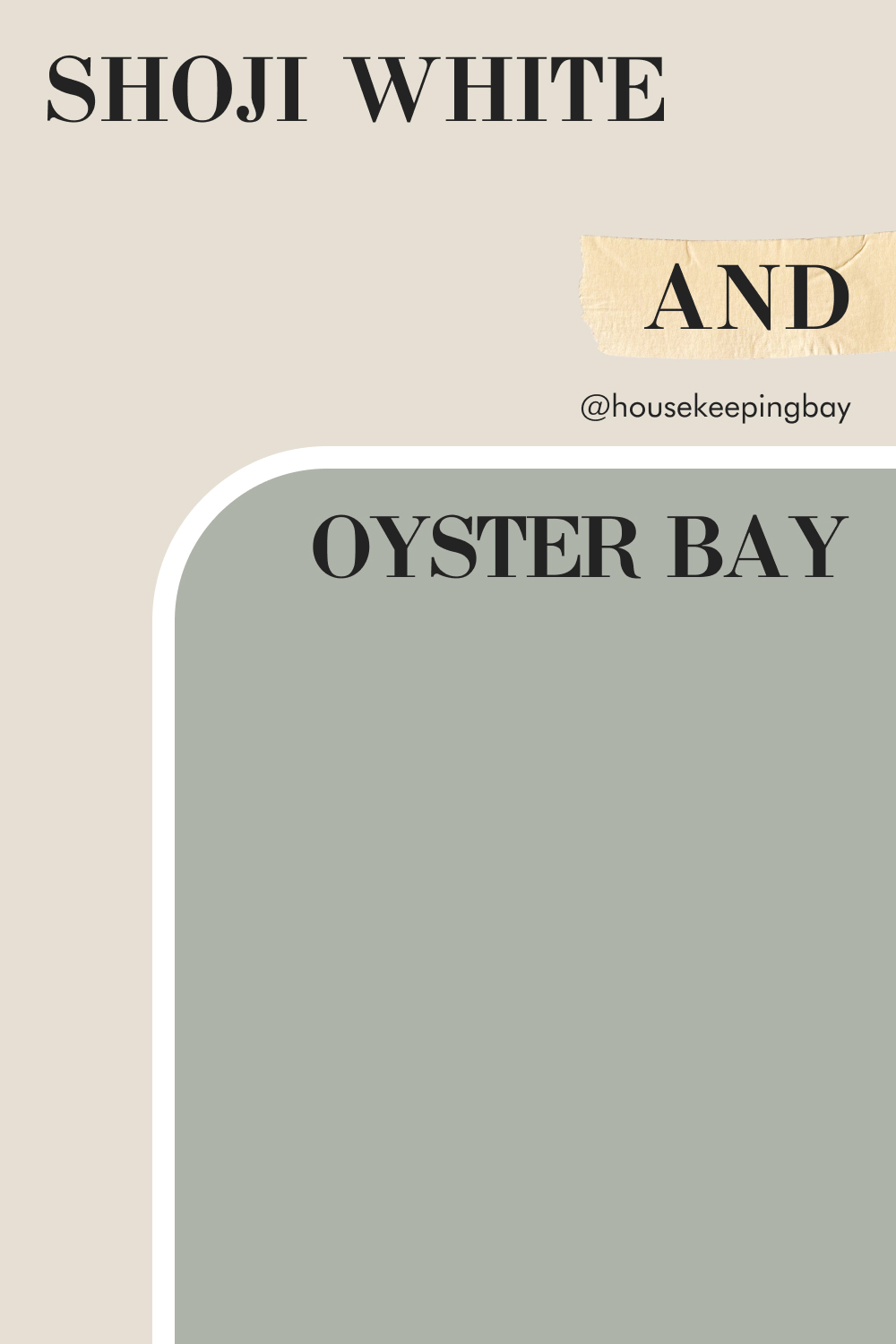
housekeepingbay.com
Shoji White (SW 7042) and Revere Pewter (HC-172)
Shoji White and Revere Pewter create a cozy, inviting palette. Shoji White offers a warm and gentle base, while Revere Pewter adds a classic, slightly warm gray tone, perfect for a balanced and approachable interior.
This pairing works well in any room, from living areas to bedrooms. Shoji White keeps the space light, while Revere Pewter brings a timeless quality, making it ideal for creating a calm, cohesive look.

housekeepingbay.com
Shoji White (SW 7042) and Snowbound (SW 7004)
Shoji White and Snowbound bring a soft, airy feel with subtle contrast. Shoji White’s warm undertones offer a touch of coziness, while Snowbound’s cooler white adds brightness, creating a fresh and clean look that suits any modern or classic decor.
This combination is perfect for spaces that need a light, refreshing ambiance. Shoji White adds warmth, while Snowbound keeps things crisp, making it an ideal choice for kitchens, bathrooms, or living areas.

housekeepingbay.com
Shoji White (SW 7042) and White Dove (OC-17)
Shoji White and White Dove form a soft, cohesive white-on-white pairing. Shoji White’s subtle warmth complements White Dove’s gentle, creamy undertones, creating an elegant look with just a hint of contrast.
This pairing is ideal for spaces where you want a bright, seamless look. Shoji White brings warmth, while White Dove adds a refined touch, making it perfect for kitchens, dining rooms, or bedrooms for a sophisticated yet comfortable atmosphere.
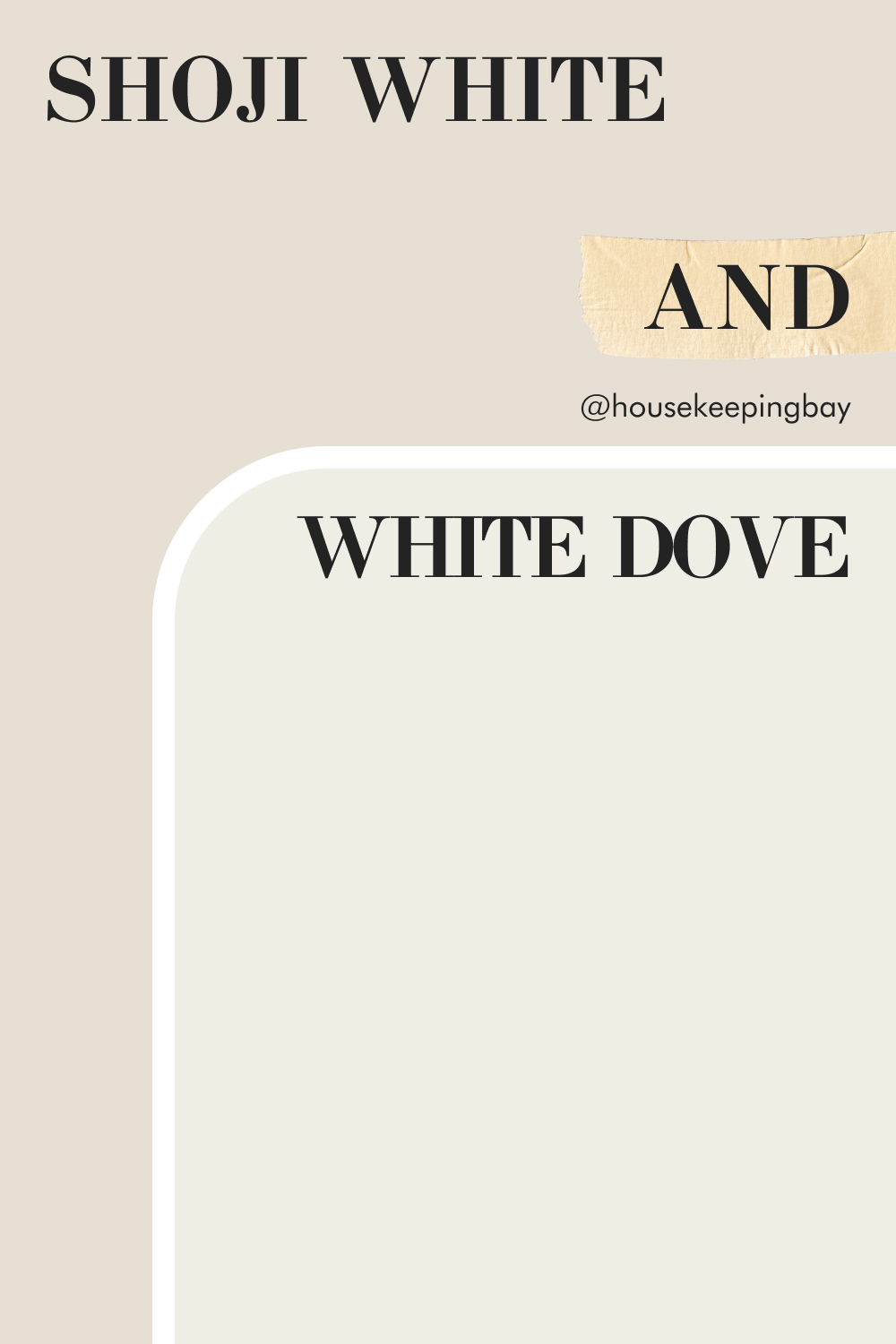
housekeepingbay.com
Comparing Shoji White With Other Colors
White colors may seem the same to quite many of us. But they are still different because there are warmer whites and cooler whites, as well as brighter and duller ones. Below, you can read and compare Shoji White with a few other white shades so that you could have a better understanding of the subject.
Shoji White (SW 7042) vs Alabaster (SW 7008)
Shoji White and Alabaster offer two inviting off-white options. Shoji White has a hint of beige, giving it a slightly warmer feel, while Alabaster has a softer, more neutral tone that feels equally welcoming.
Both colors work well as neutrals, making them versatile choices for any room. Shoji White adds a bit more warmth, ideal for cozy spaces, while Alabaster’s softer tone brings a subtle elegance, making either choice ideal for creating a calming backdrop.

housekeepingbay.com
Shoji White (SW 7042) vs Ballet White (OC-9)
Shoji White and Ballet White offer soft, warm neutrals with distinct personalities. Shoji White brings a gentle warmth, while Ballet White leans toward a slightly lighter, creamy beige, creating an airy feel in any room.
Perfect for spaces that need a comfortable, welcoming vibe, Shoji White offers a subtle warmth, while Ballet White provides a lighter, refined touch. Both work well as base colors, complementing a range of accent colors and styles.
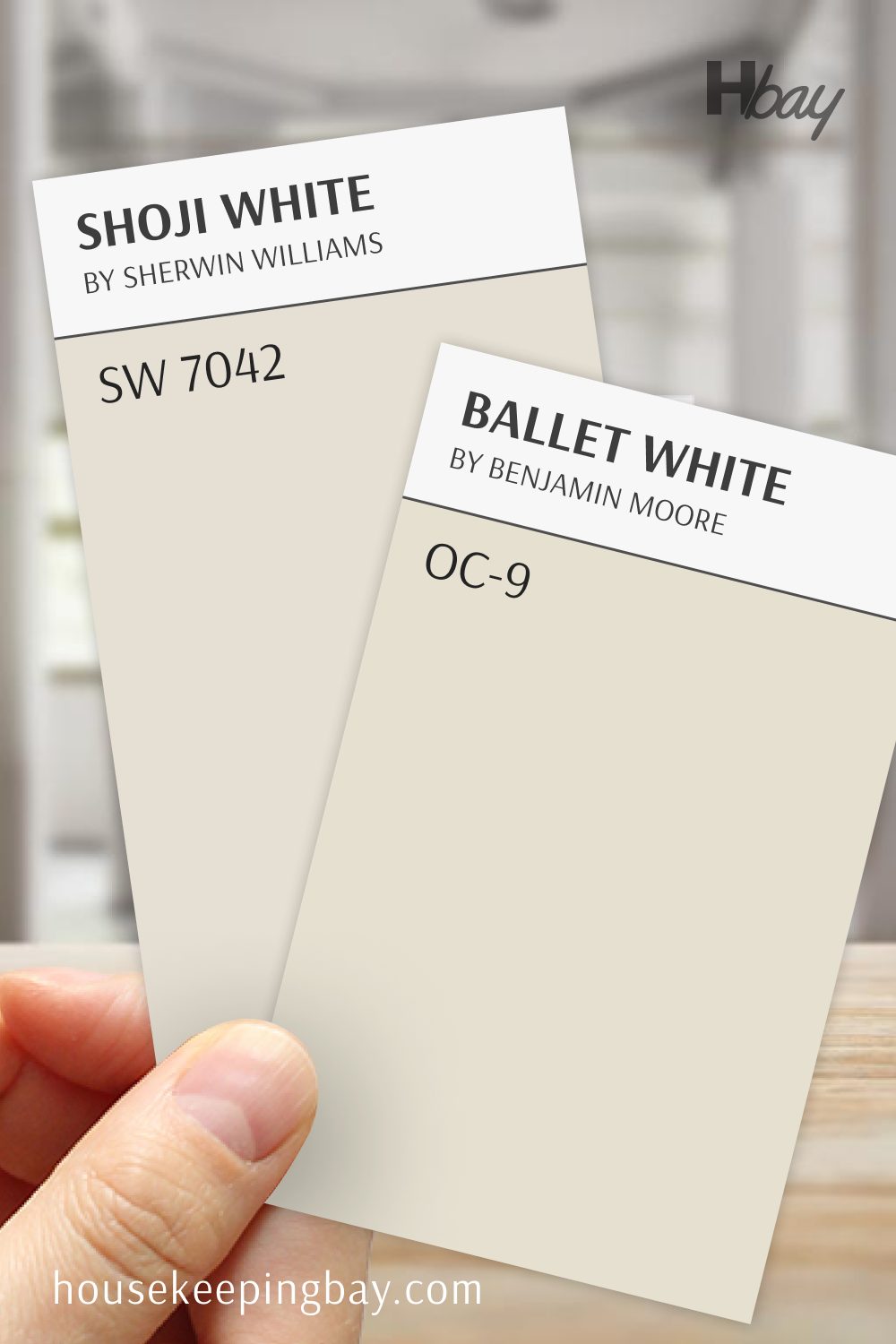
housekeepingbay.com
Shoji White (SW 7042) vs Creamy (SW 7012)
Shoji White and Creamy create two versatile warm options with subtle differences. Shoji White has a soft beige undertone, while Creamy has a slightly more pronounced yellow tone, giving it a hint of brightness.
Both colors bring warmth and are excellent choices for creating inviting spaces. Shoji White offers a more muted warmth, while Creamy adds a touch of light, making each suitable for living rooms, kitchens, or hallways.
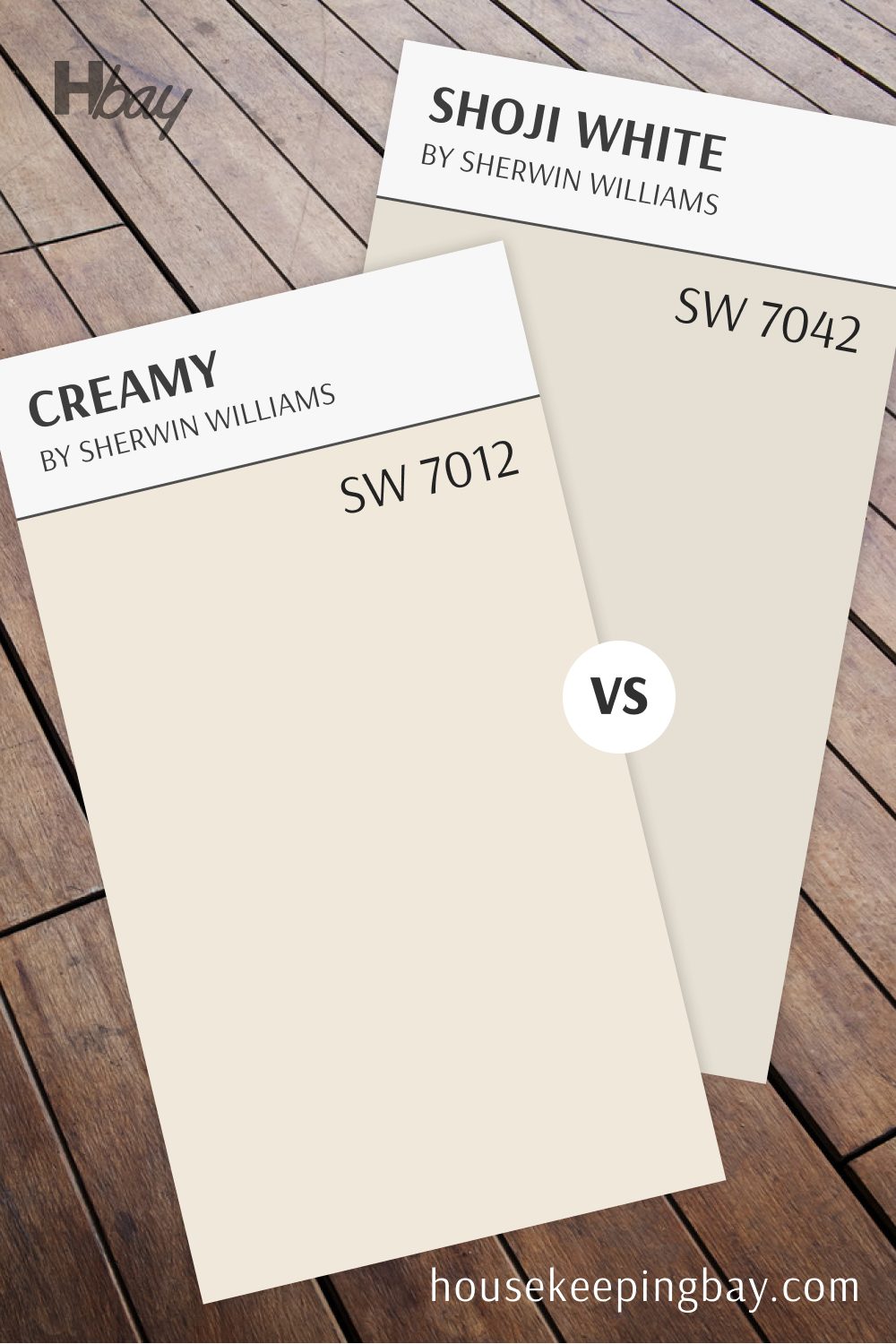
housekeepingbay.com
Shoji White (SW 7042) vs Dover White (SW 6385)
Shoji White and Dover White provide warm, neutral options with distinct characters. Shoji White has a subtle beige undertone, while Dover White leans toward a soft cream, adding a bit more warmth to any room.
Perfect for creating cozy spaces, Shoji White gives a gentle warmth, while Dover White introduces a brighter, creamier feel. Both are ideal for interiors where a warm, inviting atmosphere is desired.
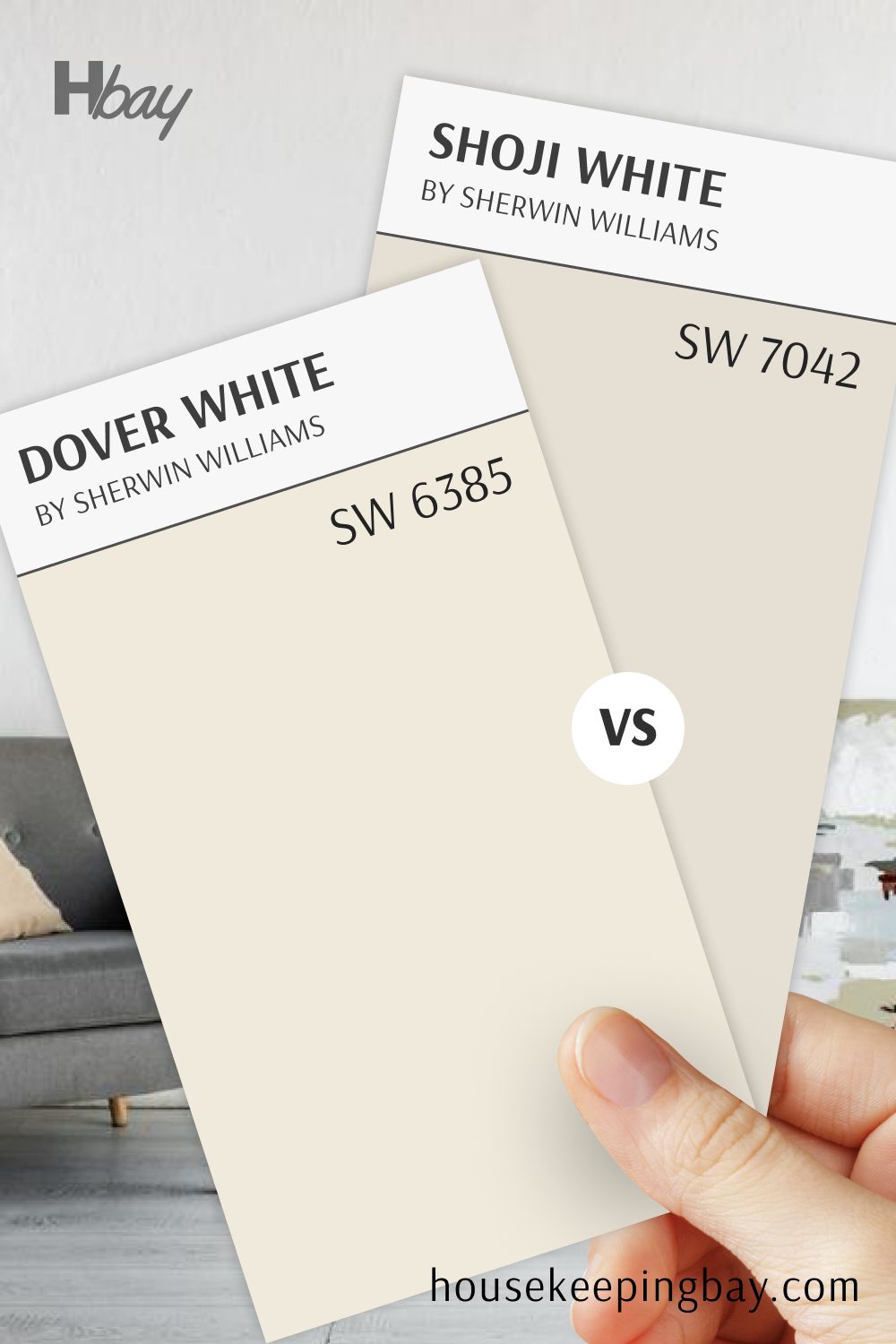
housekeepingbay.com
Shoji White (SW 7042) vs Edgecomb Gray (HC-173)
Shoji White and Edgecomb Gray are two versatile neutrals with warm undertones. Shoji White leans towards a light beige, while Edgecomb Gray offers a soft greige, creating a modern, balanced look.
Ideal for any room, this pairing provides a subtle contrast, with Shoji White adding lightness and Edgecomb Gray introducing a grounded tone. Together, they work well in open-concept spaces or areas that need a cohesive, timeless feel.
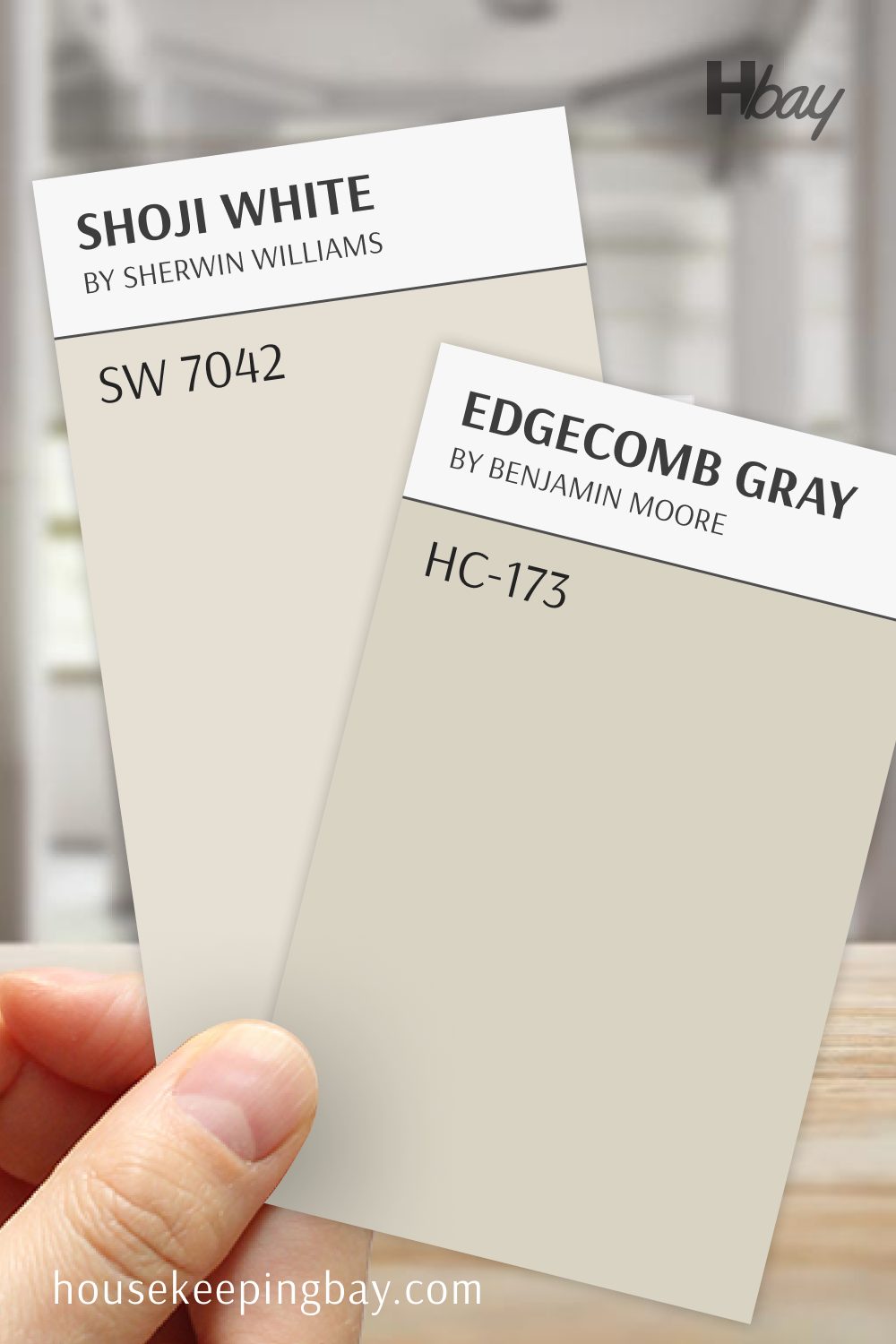
housekeepingbay.com
White Flour (SW 7102) vs Shoji White (SW 7042)
White Flour and Shoji White both bring gentle warmth to any space. Shoji White has a hint of beige, giving it a slightly warmer look, while White Flour leans towards a creamy, clean finish for a bright feel.
These two neutrals are versatile choices for any interior. Shoji White offers a bit more warmth, making it cozy, while White Flour brings brightness and freshness, ideal for spaces needing a clean, inviting feel.

housekeepingbay.com
Shoji White (SW 7042) vs Heron Plume (SW 6070)
Shoji White and Heron Plume create a soft, warm neutral pairing. Shoji White has a light beige tone, while Heron Plume is more muted, adding a quiet elegance to any space.
This combination is perfect for rooms that need a subtle contrast. Shoji White keeps the space feeling warm, while Heron Plume brings a refined softness, ideal for bedrooms, living rooms, or any space that needs a gentle, inviting look.

housekeepingbay.com
Shoji White (SW 7042) vs Ivory Lace (SW 7013)
Shoji White and Ivory Lace offer warm, soft tones with distinct undertones. Shoji White’s hint of beige makes it warm, while Ivory Lace has a creamy undertone, adding a touch of light to any room.
This pairing is perfect for creating a cozy, elegant atmosphere. Shoji White brings gentle warmth, while Ivory Lace adds a bit more lightness, ideal for kitchens, living rooms, or bedrooms.
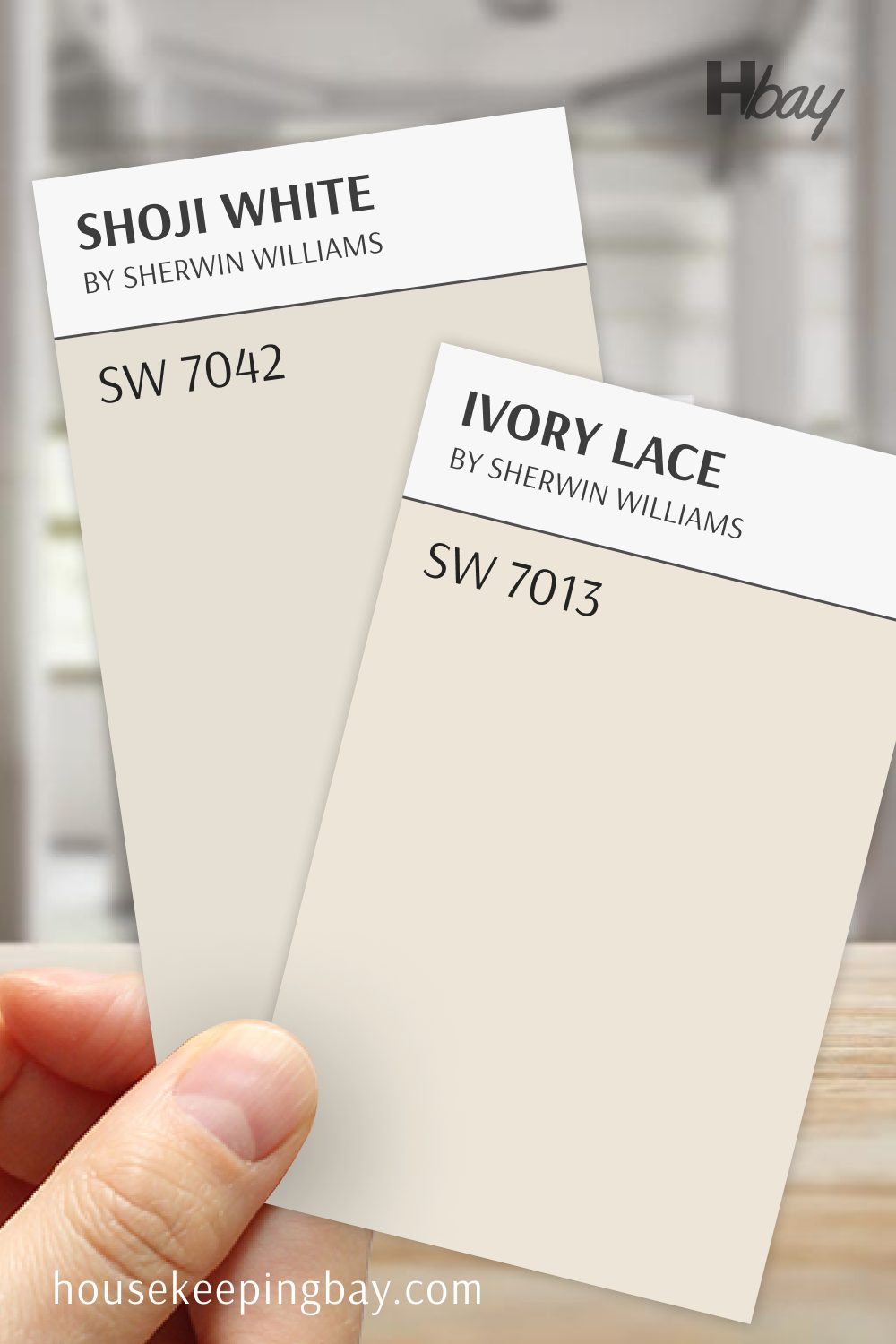
housekeepingbay.com
Shoji White (SW 7042) vs Linen White (SW 9604)
Shoji White and Linen White both offer warm, inviting neutrals. Shoji White has a subtle beige undertone, while Linen White leans towards a light, creamy finish, creating a fresh, airy look.
This pairing works well in any room, bringing a sense of openness and warmth. Shoji White offers a touch of grounding, while Linen White brightens up the space, making it ideal for kitchens, living rooms, or bedrooms.
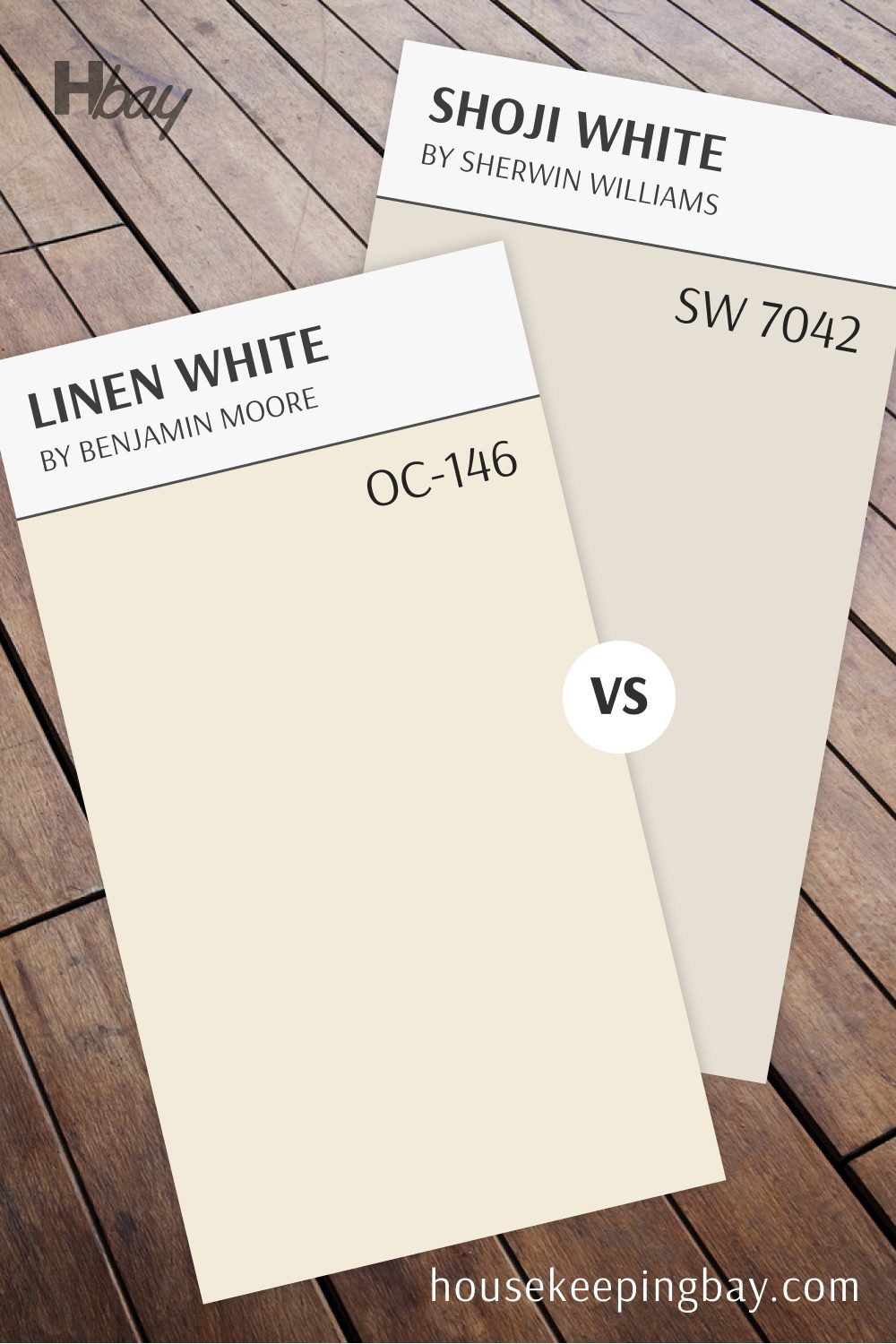
housekeepingbay.com
Shoji White (SW 7042) vs Modern Gray (SW 7632)
Shoji White and Modern Gray provide warm neutrals with subtle differences. Shoji White leans towards a light beige, while Modern Gray offers a soft greige, bringing a more grounded tone to any room.
Perfect for creating a balanced look, Shoji White adds lightness, while Modern Gray introduces a quiet sophistication, making this pairing ideal for living rooms, bedrooms, or any area needing a cozy, contemporary feel.

housekeepingbay.com
Shoji White (SW 7042) vs Toque White (SW 7003)
Shoji White and Toque White offer soft, neutral tones with subtle warmth. Shoji White has a hint of beige, while Toque White leans slightly toward a cooler white, providing a gentle contrast in any room.
This pairing is ideal for creating a clean, open feel. Shoji White adds warmth, while Toque White keeps the look fresh and balanced, making it a great choice for kitchens, bathrooms, or open-concept spaces.
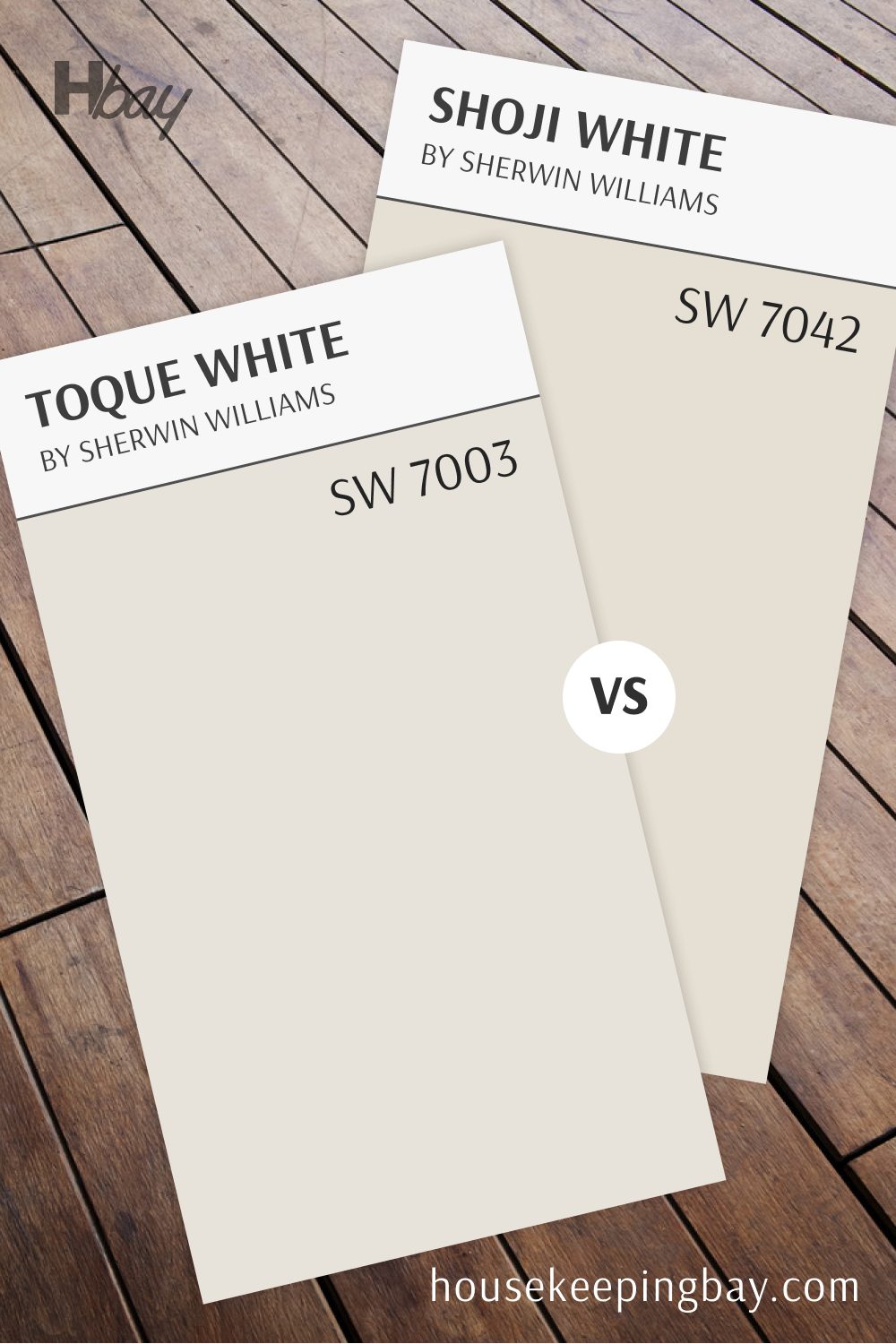
housekeepingbay.com
Zurich White (SW 7626) vs Shoji White (SW 7042)
Zurich White and Shoji White create a soft, sophisticated neutral pairing. Shoji White has a warm beige undertone, while Zurich White leans towards a cooler, balanced white, adding a touch of elegance to any room.
This combination works well in spaces needing a gentle contrast. Shoji White provides warmth, while Zurich White brings a calm, refined quality, making it ideal for living rooms, bedrooms, or dining areas.
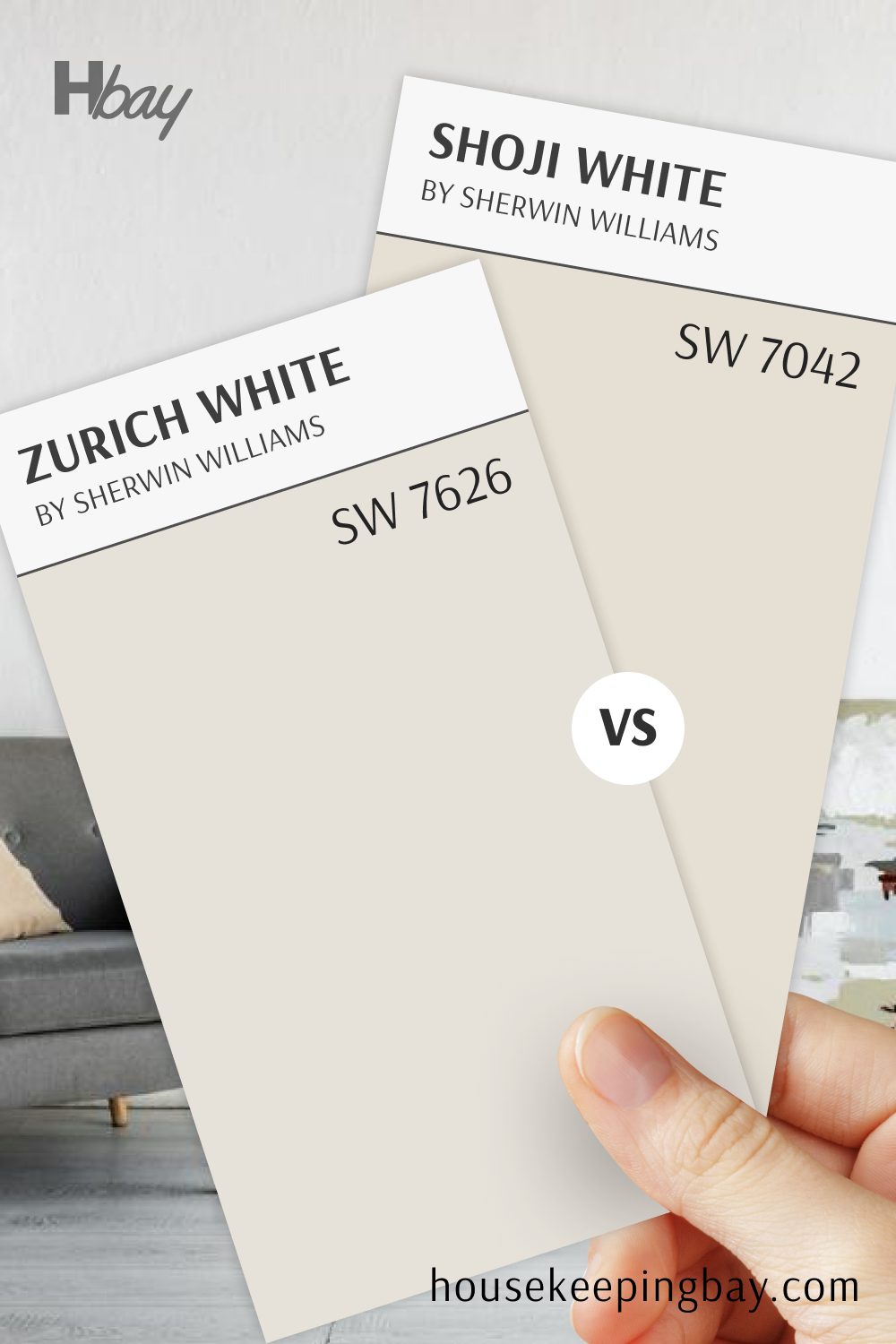
housekeepingbay.com
Shoji White vs Alabaster
In comparison to Alabaster that looks very subtle greige, Shoji White reveals its pinkish undertones quite prominently if placed side by side with the other color. Besides, Shoji White reads somewhat darker too.
In general, the two colors look rather balanced togeher, especially if you divide them with a sart and bright white to zone the space. But you might not want to use them in the same space since they don’t have a proper contrast.
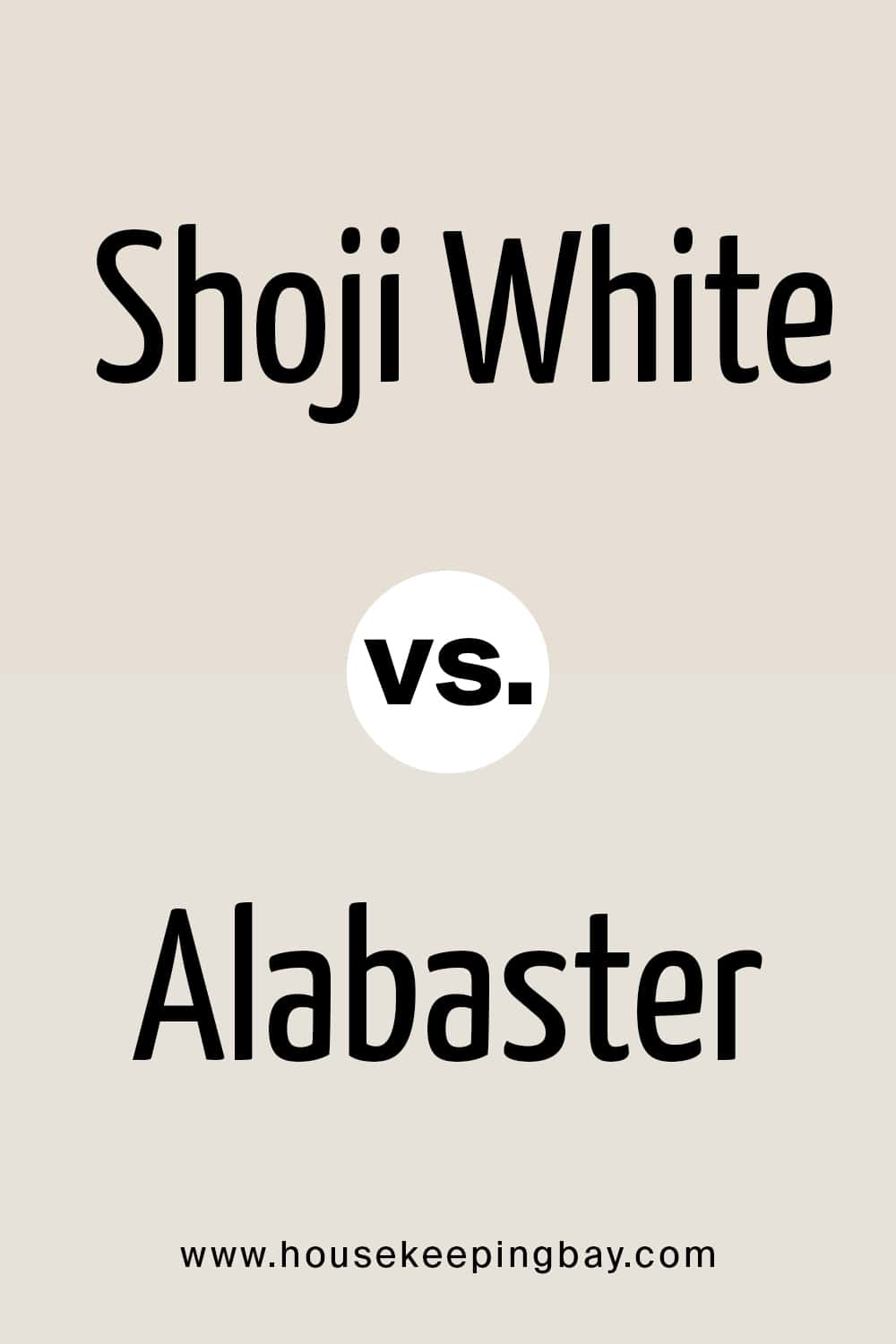
housekeepingbay.com
Shoji White vs Swiss Coffee
Swiss Coffee reads lighter in comparison to Shoji White. Besides, Swiss Coffee shows its creamy undertones quite significantly whilst Shoji White reads noticeably pinkish.
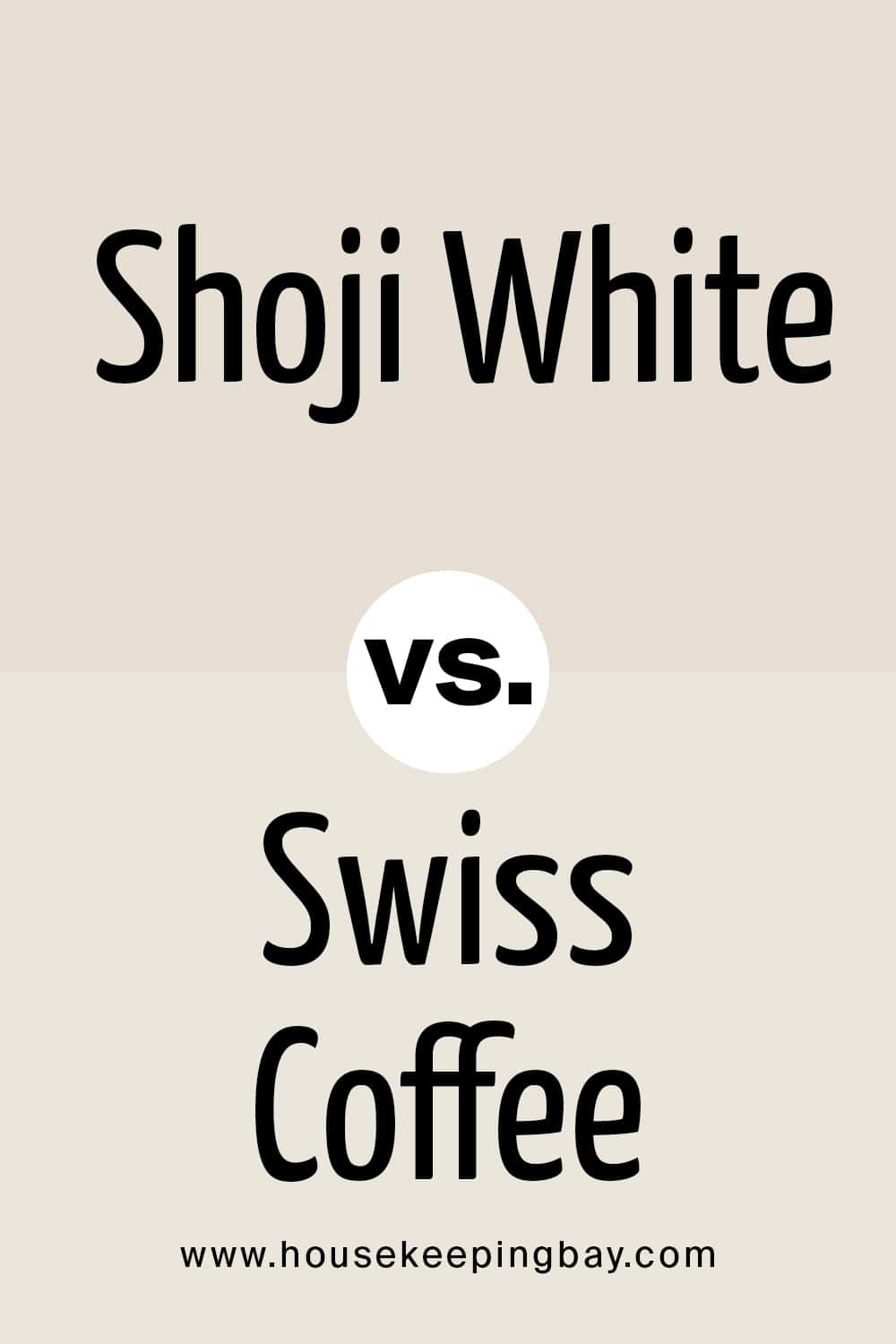
housekeepingbay.com
Shoji White vs White Duck
These two are pretty much the same. The only distinction that you can grasp is that White Duck reads a bit greige with its very beutral undertones whilst Shoji White has a slight yet noticeable hint of pink in it.
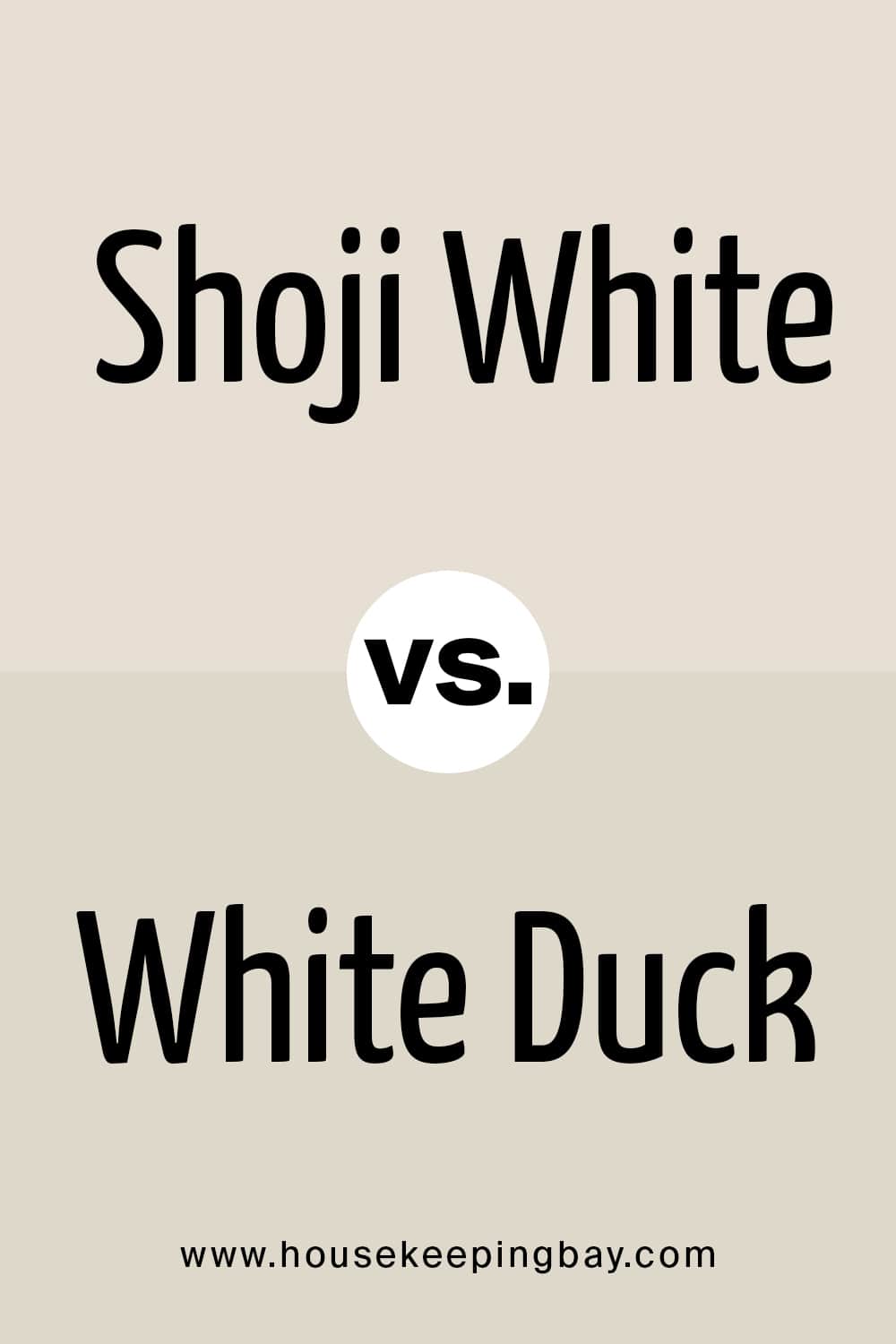
housekeepingbay.com
Shoji White vs Greek Villa
Greek Villa is a warm white that has a yellow undertone. If compared to Shoji White, you might notice that very slight yellow hue in it whilst its counterpart reads noticeably more beige.
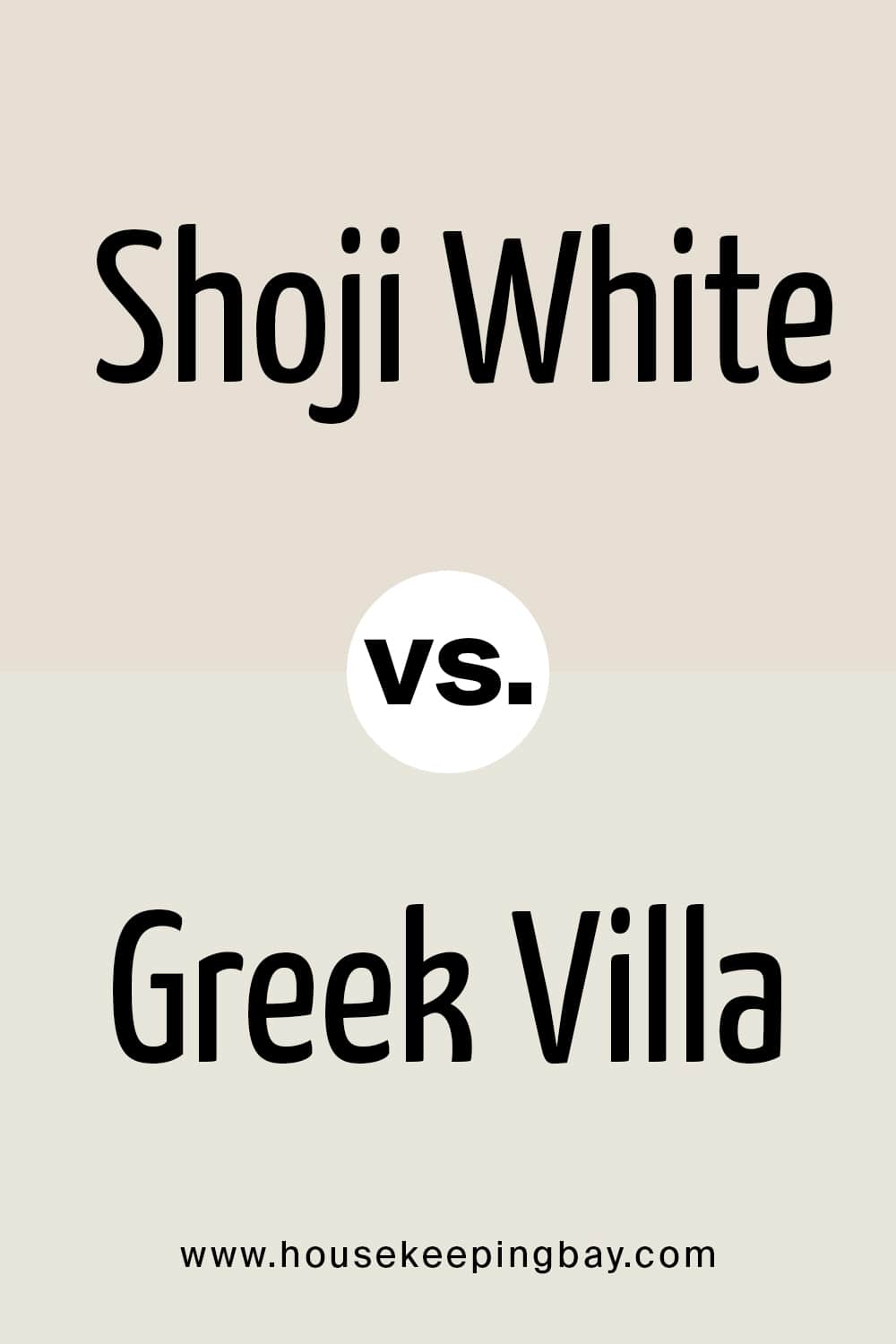
housekeepingbay.com
Shoji White vs Oyster White
These colors are so alike that you can hardly see the difference. But it exists. Oyster White is a light warm greige with soft green undertones. SW Shoji White is beige that in this case reads slightly pink.

housekeepingbay.com
Now you know how SW Shoji White paint color look and may even somewhat change is appearance being close to a few other white paint colors.
And in general, today you have learned much more about such a complex and a bit tricky beige paint color as SW Shoji White. You can figure out what room it will look better and why, and how this color may react to light on your walls. And since you know what exactly makes this paint uneasy to use sometimes, you will surely be able to make the most out of it.
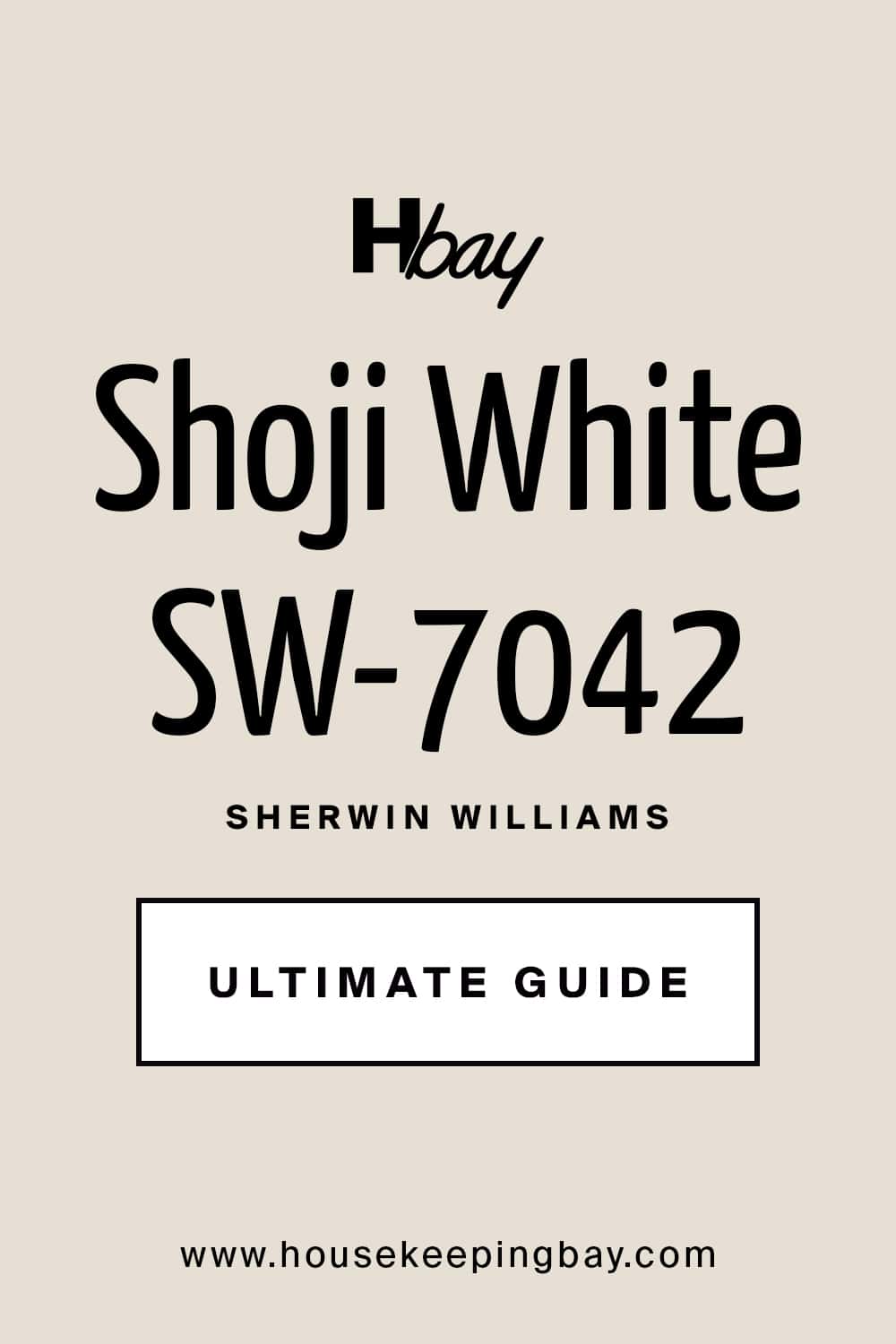
housekeepingbay.com
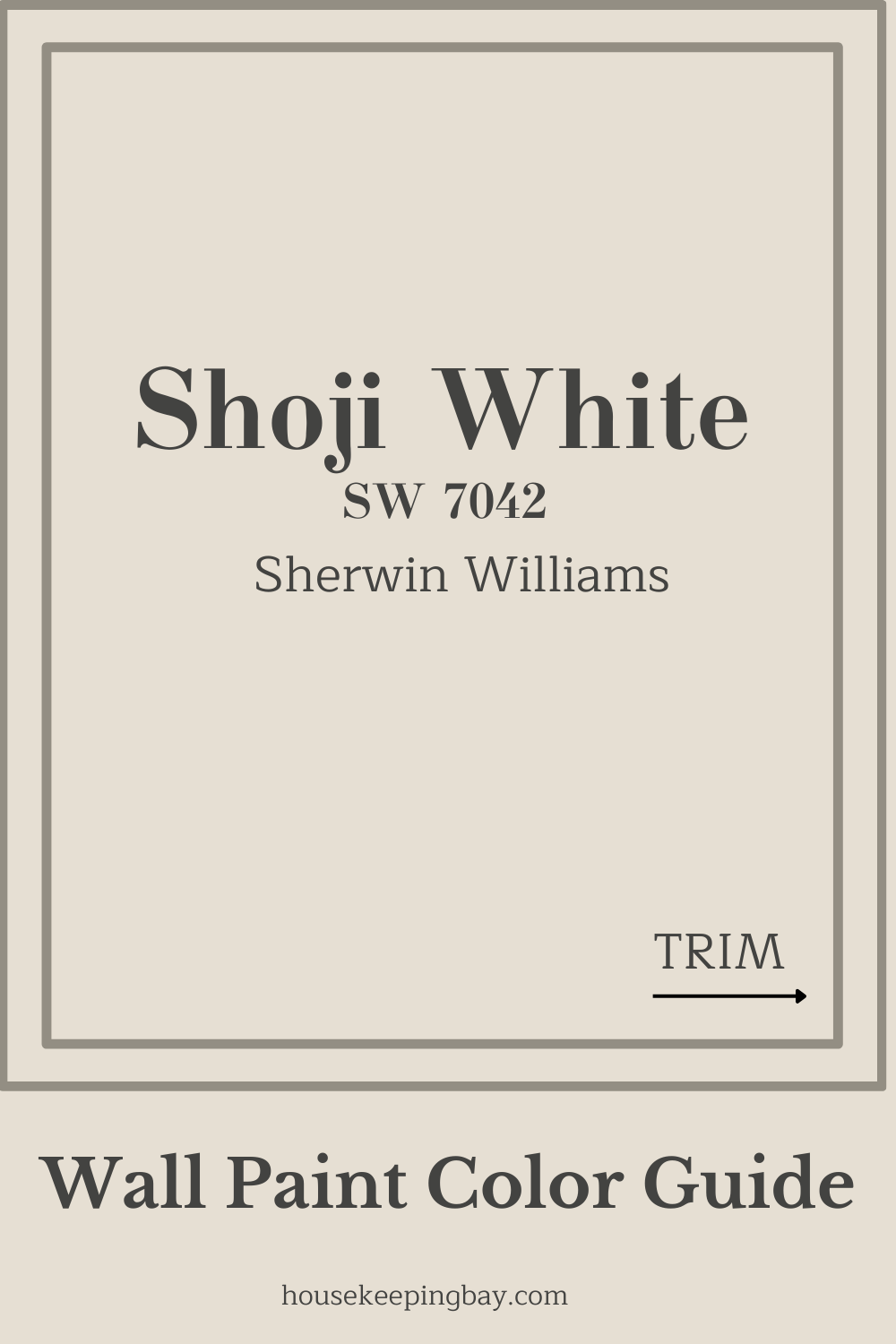
housekeepingbay.com
Ever wished paint sampling was as easy as sticking a sticker? Guess what? Now it is! Discover Samplize's unique Peel & Stick samples. Get started now and say goodbye to the old messy way!
Get paint samples




Frequently Asked Questions
⭐Is Shoji White a warm or cool color?
Shoji White is a beautiful blend of cream and greige, making it a WARM paint colour.
⭐What other colors can coordinate with Shoji White?
Coordinating colors for this paint can be SW 7640 Fawn Brindle, SW 9154 Perle Noir, and SW 7005 Pure White.
⭐Can Shoji White be considered a neutral?
Technically, yes. Shoji White has a warm greige undertone and is considered a “white” in the Sherwin-Williams paint deck. So if you have a space that needs a light off-white neutral, Shoji White could work for you!
5 thoughts on “Shoji White SW-7042 by Sherwin-Williams”
Leave a Reply

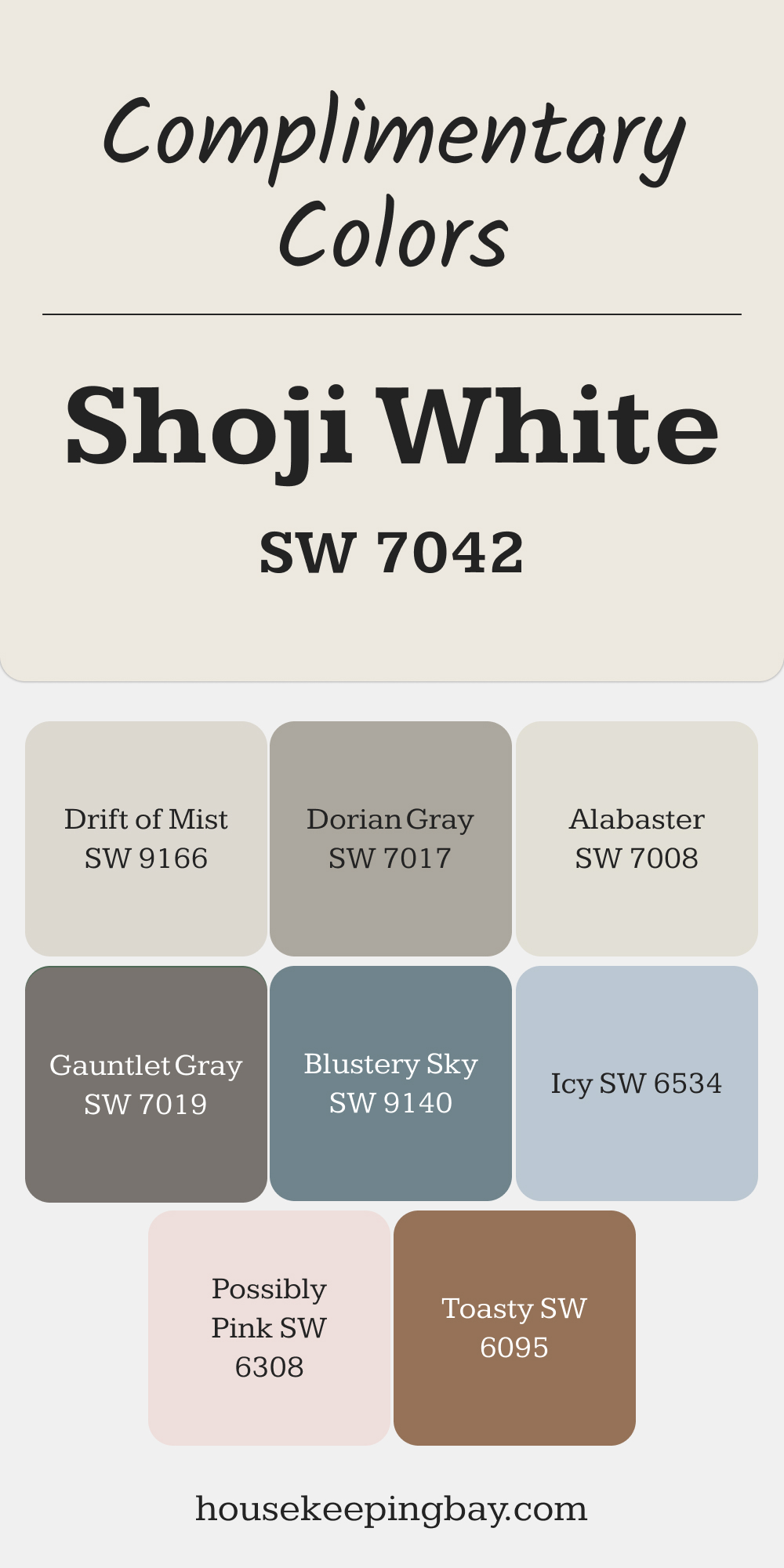
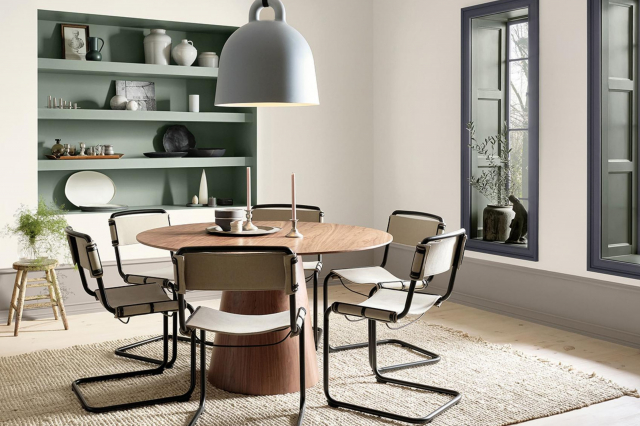
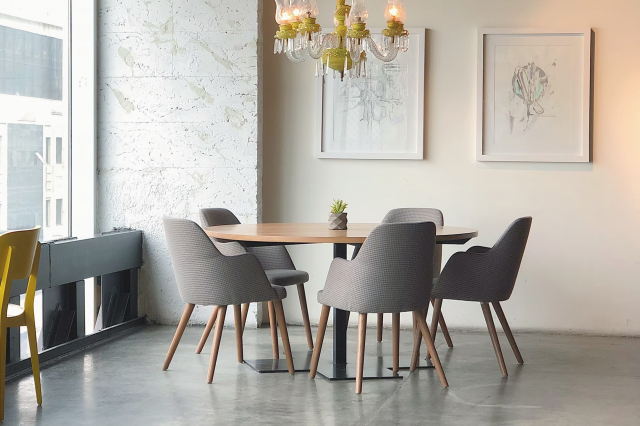
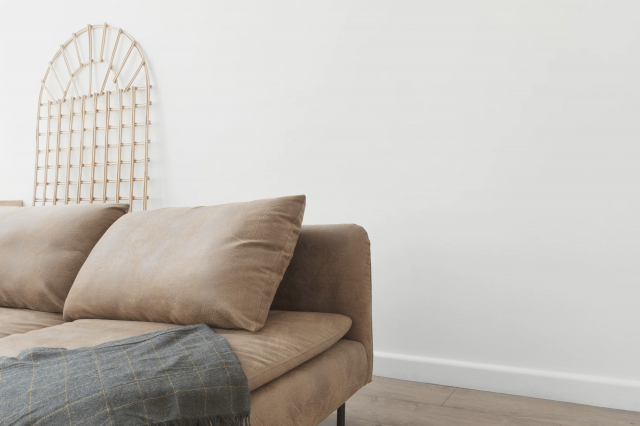
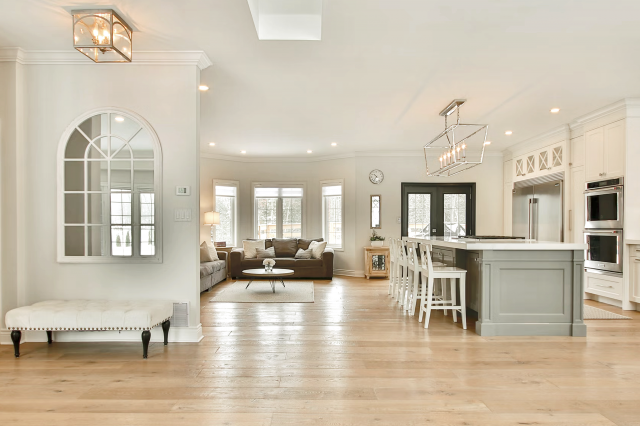
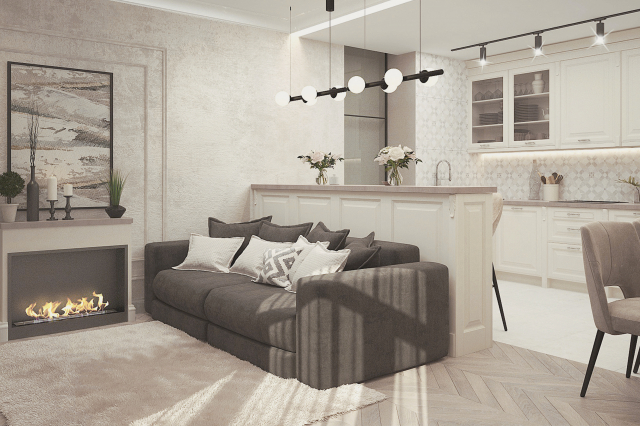
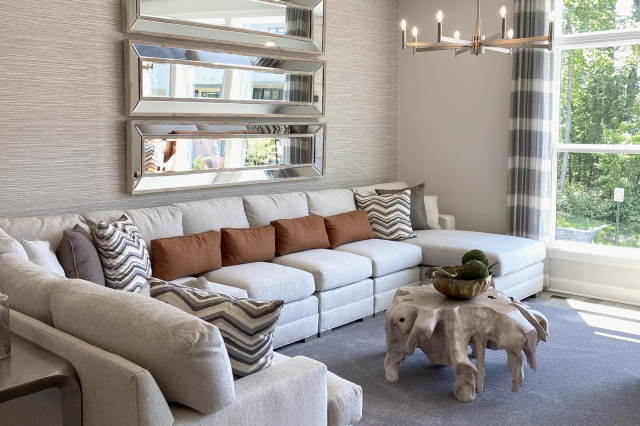

Would shoji work well with a terracotta color?
I heard that shoji White may show pinkish undertones. Is it possible this color reads pink on the walls?
I don’t think it can read literally pink. See, Shoji White is in the orange color family, so it has creamy beige undertones. However, in certain types of lighting, it can indeed read pinkish! So you’d better sample it in advance to see how it works.
Hi! Could you please help me with the color selection. Will Shoji White go well with Greek Villa?
Hello! WEll, I’m sure it will! As a shade of white, Greek Villa works well with other neutrals and other whites, grays, or browns. And among the whites you can pair with the color there are Alabaster (SW 7008) and Shoji White (SW 7042).